Welcome to a place where the old meets the new in a beautiful blend, where age-old traditions exist side by side with cutting-edge innovations. This is Japan, home to awe-inspiring landmarks from the grand Mount Fuji to the mesmerizing Fushimi Inari Shrine.
In this article, I will share the most famous landmarks in Japan, as well as some hidden gems that showcase the incredible diversity of this nature – focused country. The best part? Most of these landmarks can be visited using our 3-week Japan itinerary including well known places like Shibuya Crossing, Arashiyama Bamboo Forest and, of course the majestic Mount Fuji.
Get ready to discover the famous Japanese landmarks that have captured the hearts of many and are on the bucket list of travellers worldwide.
Table of Contents
- 30 Epic Landmarks in Japan
- Mount Fuji, Yamanashi
- Shibuya Crossing, Tokyo
- Arashiyama bamboo grove, Kyoto
- Fushimi Inari Shrine, Kyoto
- Itsukushima shrine, Hiroshima
- Senso-ji, Tokyo
- Kinkaku-ji, Kyoto
- Himeji castle, Himeji
- Hiroshima Peace Memorial, Hiroshima
- Meiji Shrine, Tokyo
- Gion District, Kyoto
- Dotonbori, Osaka
- Shirakawa-go, Gifu
- Osaka Castle, Osaka
- Todai-ji Temple, Nara
- Tokyo Tower, Tokyo
- Tokyo Skytree, Tokyo
- Nikko Toshogu Shrine, Tochigi
- Naoshima, Kagawa
- Tokyo Imperial Palace, Tokyo
- Kōtoku-in, Kanagawa
- Jigokudani Monkey Park, Nagano
- Yakushima Island, Kagoshima
- Kiyomizu-Dera, Kyoto
- Kenrokuen Garden, Ishikawa
- Tokyo Yokocho, Tokyo
- Chureito Pagoda, Yamanashi
- Blue Pond, Hokkaido
- Seiganto-ji, Wakayama
- Yoshino Trees, Nara
- Frequently Asked Questions
30 Epic Landmarks in Japan
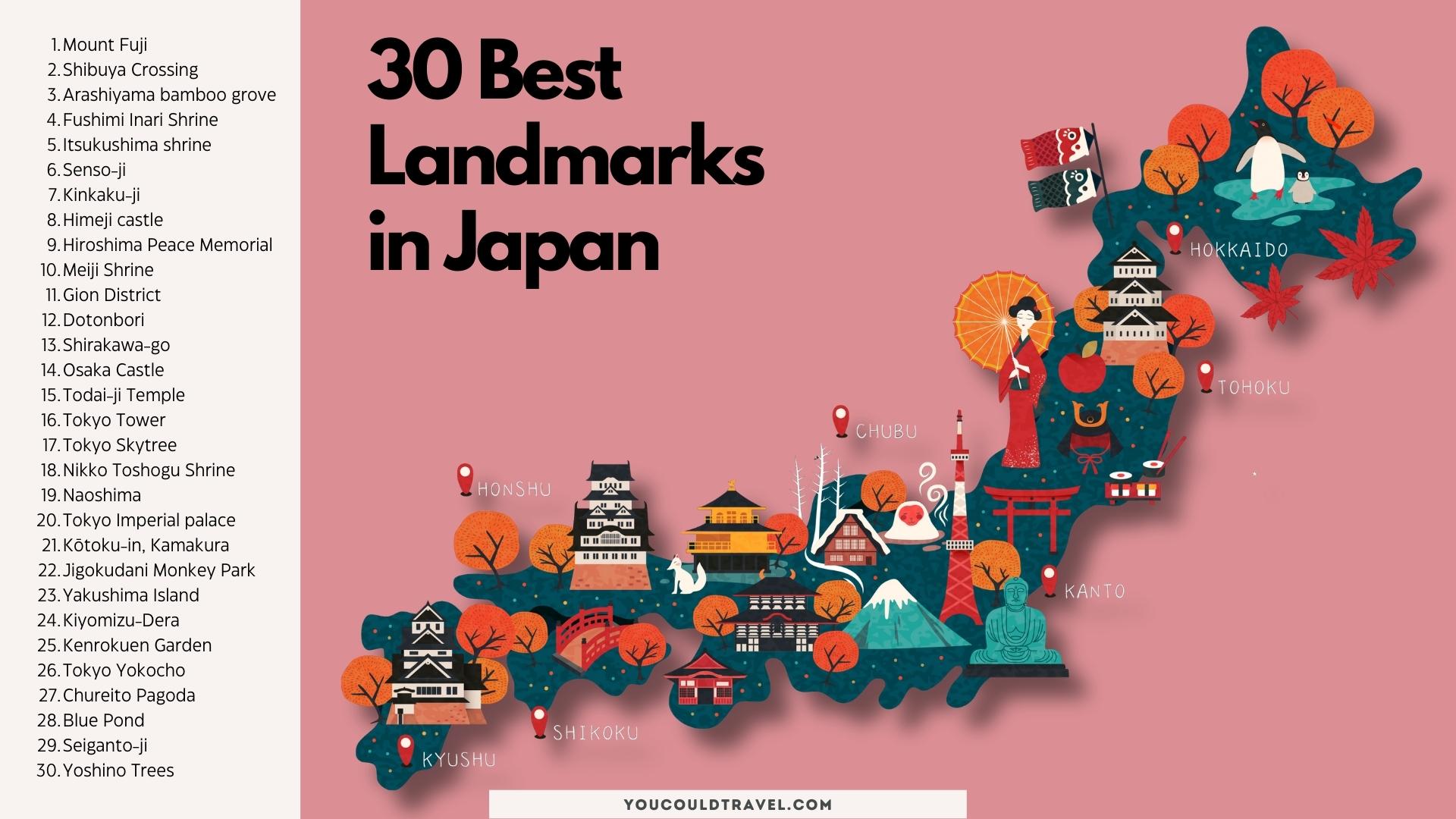
These top 30 landmarks in Japan will take you to 16 different prefectures around the country. You will also travel between the three main islands of Honshu, Hokkaido, and Kyushu and discover smaller islands too, such as Miyajima, Naoshima and Yakushima.
Mount Fuji, Yamanashi
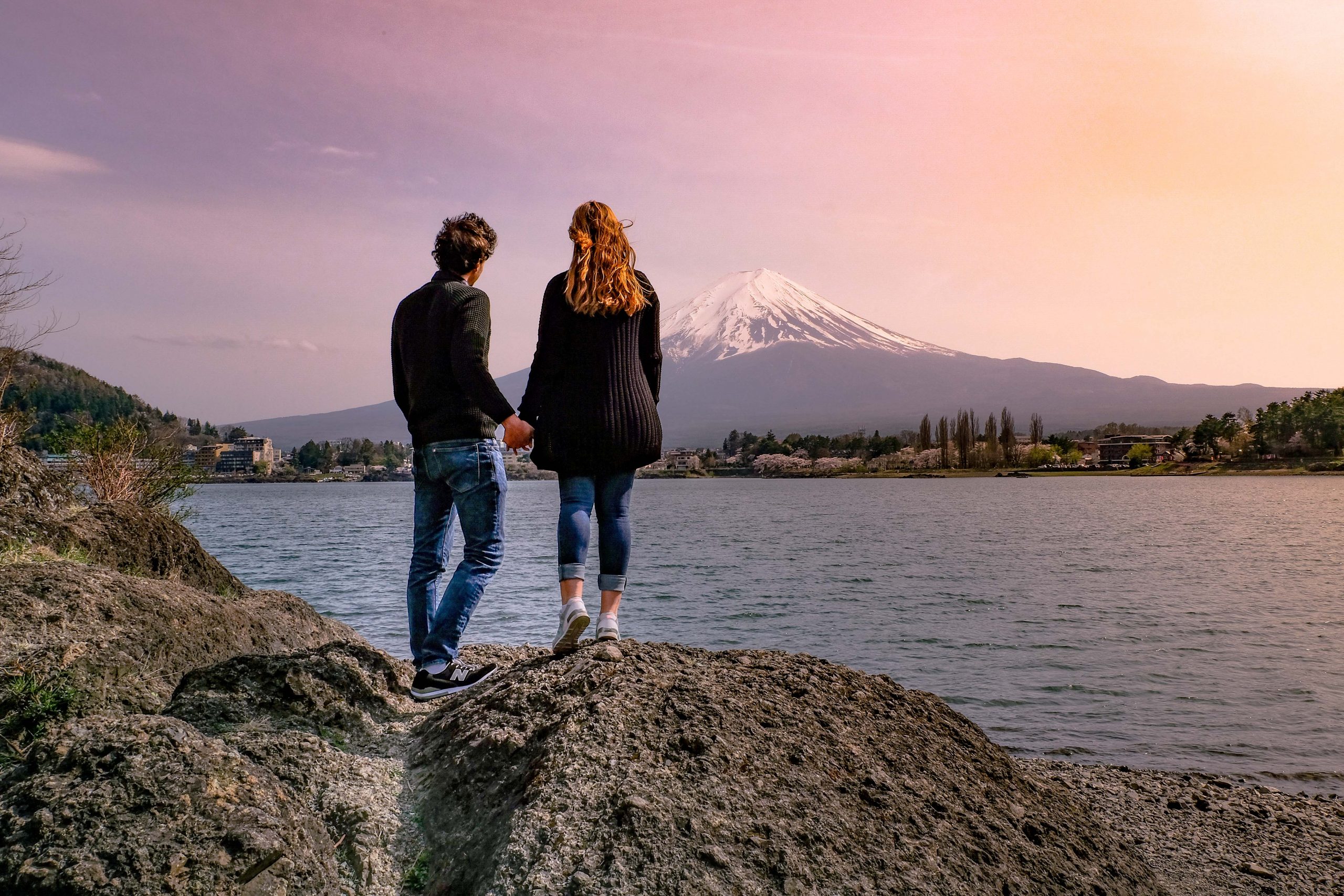
Mount Fuji, or Fujisan as it’s known in Japanese, is the country’s tallest peak and perhaps its most iconic landmark of them all. Standing at 3,776 meters (12,389 feet), this active volcano has long been a symbol of Japan and a source of inspiration for artists for thousands of years. Mount Fuji’s symmetrical cone is considered a sacred site, and it is an essential stop on any Japanese itinerary. It is a designated UNESCO World Heritage Site, recognized for its cultural, historical, and spiritual value.
The official climbing season is from early July to early September. The climb to the top is challenging, but there are various trails to accommodate different skill levels. If you wish to view Mount Fuji from afar, there are many vantage points in the surrounding area. The Fuji Five Lakes region offers one of the most picturesque views of the volcano. Lake Kawaguchi is the most popular and easiest to access as a day trip from Tokyo. On clear days, you can even spot Mount Fuji from tall buildings in Tokyo.
While Mount Fuji is a year-round destination, winter is often the best time to spot the volcano as the air tends to be clearer with fewer clouds.
Shibuya Crossing, Tokyo
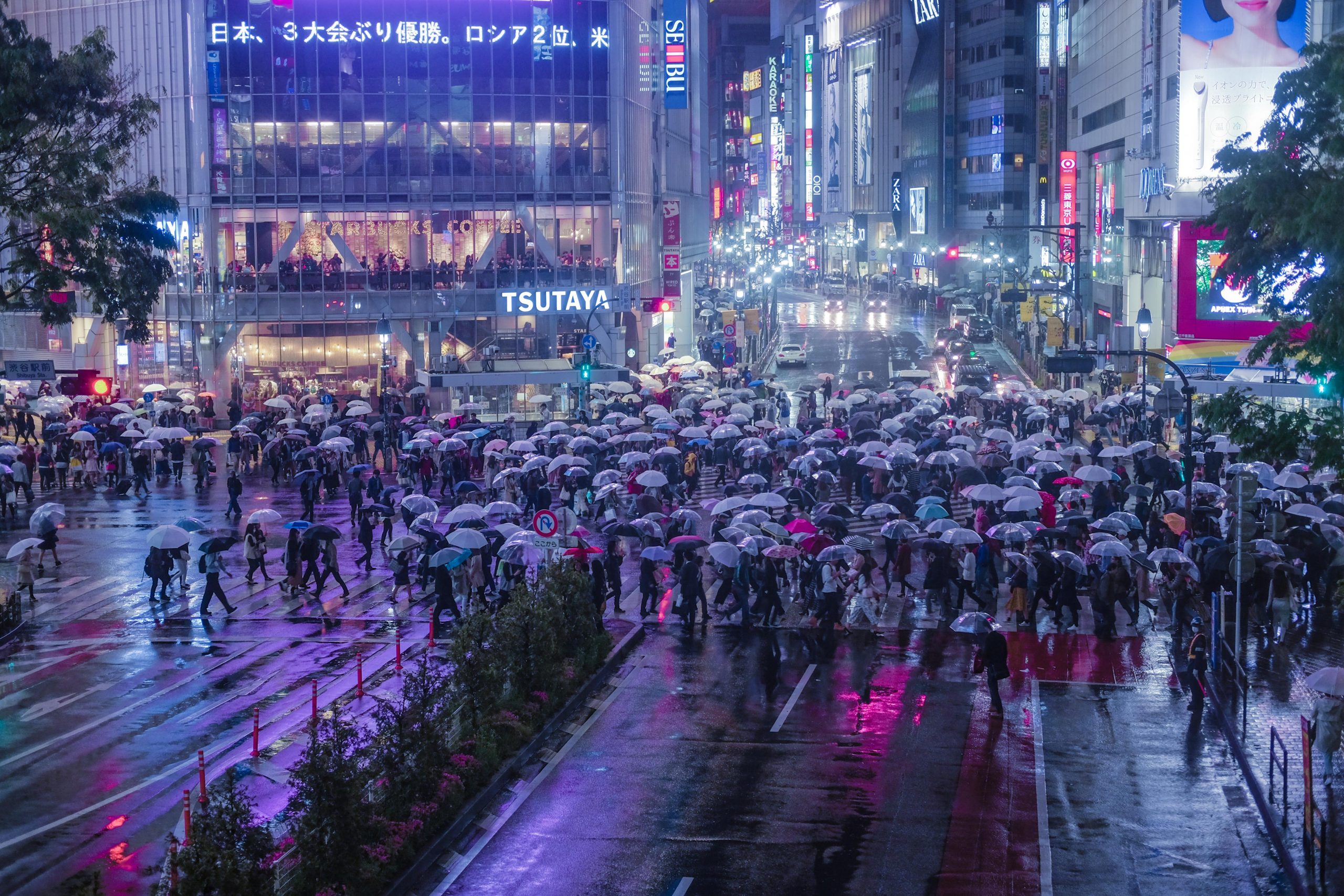
Shibuya Crossing is one of the most famous and iconic landmarks in Tokyo. It’s located in the Shibuya district, a lively and youthful neighbourhood with lots of shopping, food and entertainment.
Shibuya is the world’s busiest pedestrian intersection, and at rush hours you’ll cross it with thousands of other people. Yes, at the same time! In fact, over 2 million people cross the Shibuya pedestrian scramble every single day.
Personally, I think Shibuya Crossing is one of the best things to do in Tokyo so make sure to add it to your itinerary. The best time to visit the crossing is during the evening rush hour to really have the full experience.
The crossing is surrounded by skyscrapers, colourful billboards and neon lights, sometimes with music and loud ads everywhere. It’s really fun, modern and feels like the city is alive. To fully experience Shibuya Crossing, make sure to pick a vantage point to admire it from above.
Try the Shibuya Sky observation deck, the Starbucks located on the second floor of the Tsutaya building or the L’Occitane Café. One of my favourite places to admire Shibuya Crossing is the Hikarie building, which is free to visit.
Aside from crossing the intersection, Shibuya is a great hub for shopping, with plenty of restaurants, department stores and fun cafés. Head to Shibuya Centre Gai to get started. There is even the Shibuya Dogenzaka & Love Hotel Hill nearby.
Arashiyama bamboo grove, Kyoto
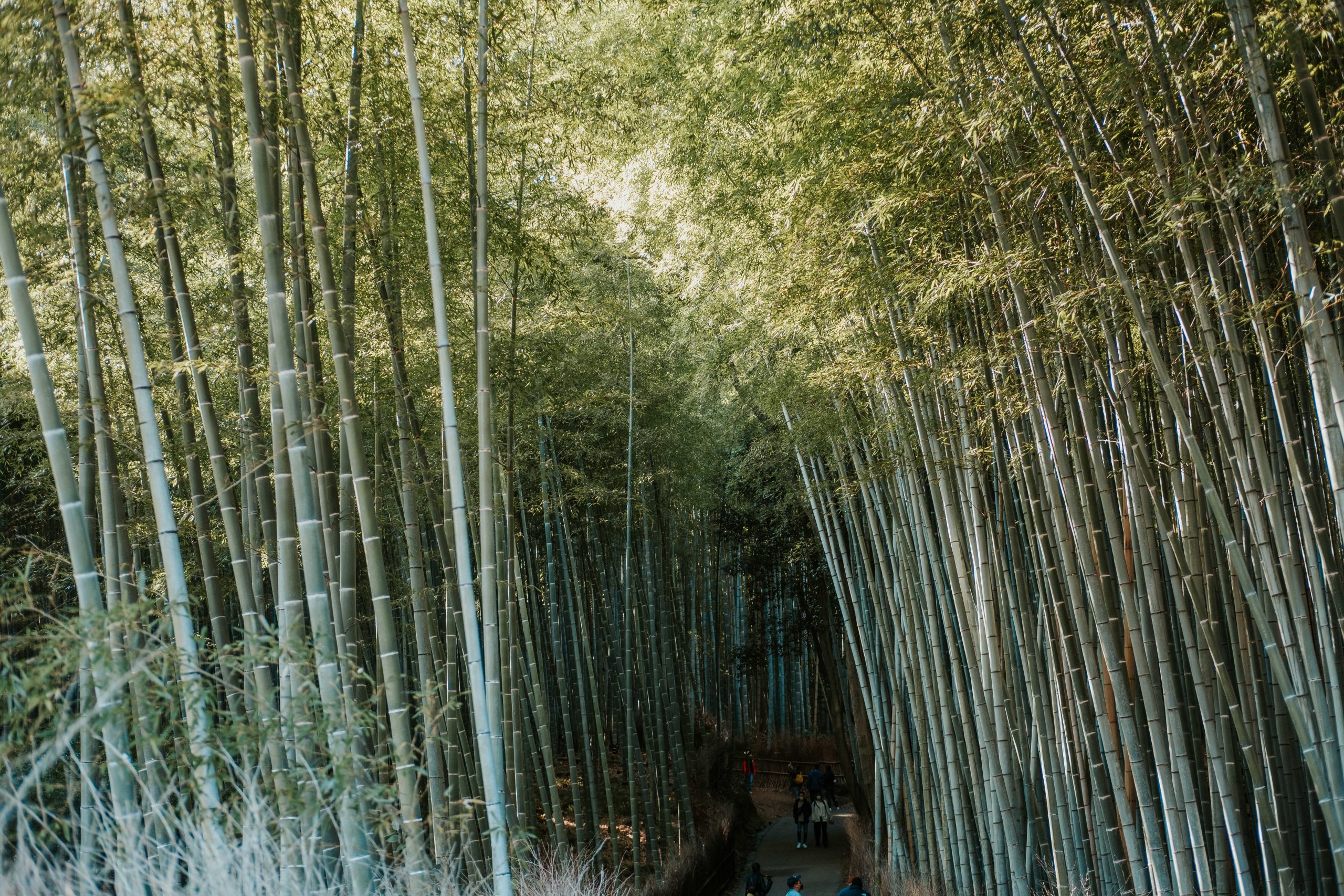
The Arashiyama Bamboo Grove in Kyoto, is one of the most famous and visited places in Japan. You’ll see this perfectly symmetrical walking path, lined with very tall and thick bamboo stalks that gently sway in the wind.
The path leads you into the forest, and it continues towards many attractions in the area. Don’t miss the Okochi Sanso Garden, a beautiful landscaped garden with beautiful views of the surrounding mountains. You’ll even get a traditional matcha tea and wagashi included in the ticket. Afterwards, make your way to the Saga Toriimoto Preserved Street, a quiet street lined with traditional wooden houses, where you’ll find the Adashino Nenbutsu-ji Temple, a stunning temple with another, lesser known bamboo forest.
Due to its immense popularity, the Arashiyama Bamboo Grove can get quite busy, especially during the cherry blossom season. Arrive early in the morning, especially if you wish to take great pictures without the crowds. Consider visiting the grove in mid-December during the annual Arashiyama Hanatouro illumination event, when the bamboo groves are beautifully illuminated after 5 pm.
The bamboo grove is located in the Arashiyama Mountains, on the eastern side of Kyoto and can easily be visited during a visit to Kyoto.
Fushimi Inari Shrine, Kyoto
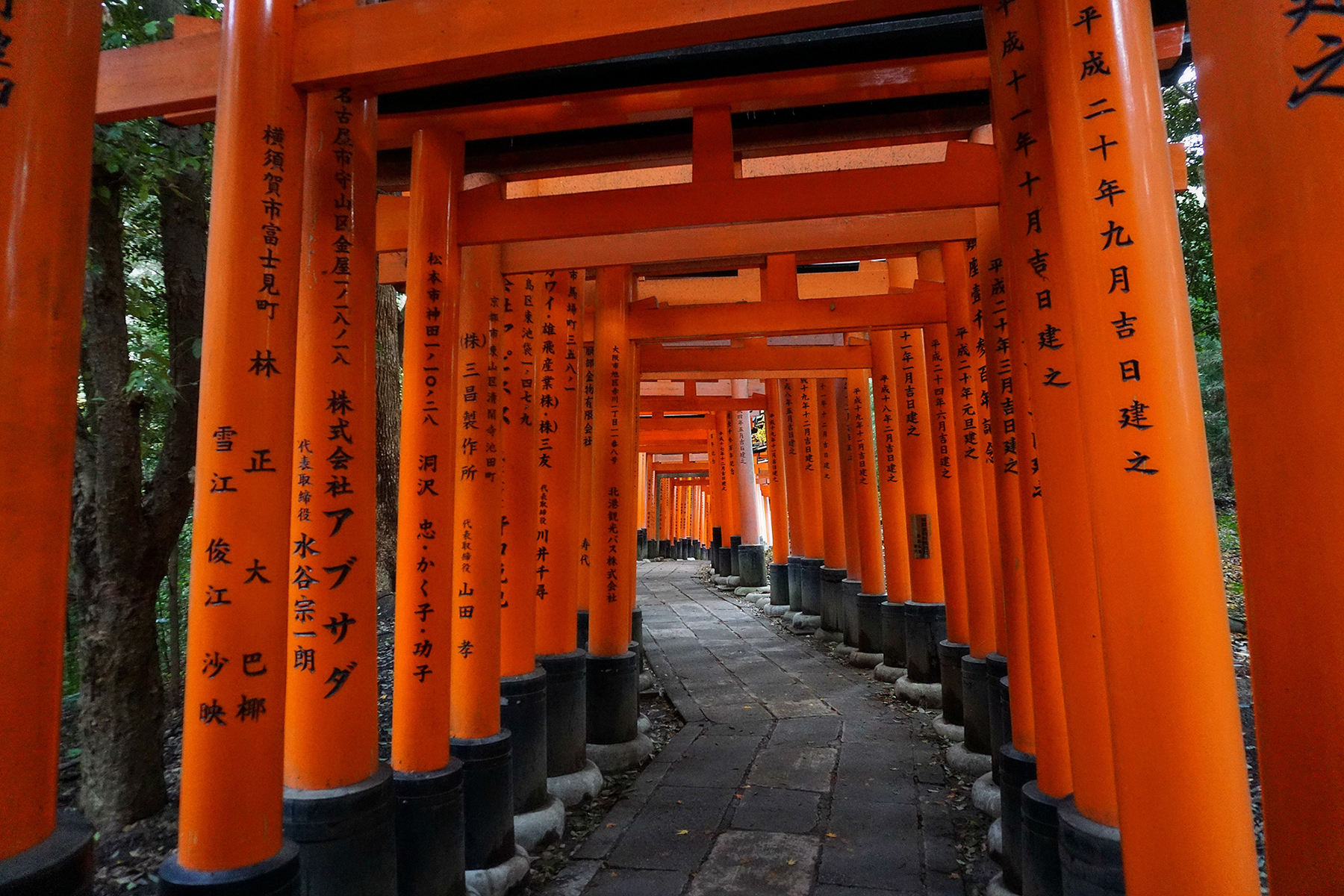
One of the most famous Shinto shrines in the whole world, let alone Japan, is the beautiful Fushimi Inari Shrine. Fushimi Inari Shrine has rows of thousands of vermilion torii gates that create a tunnel-like effect up Mount Inari. While it is a popular tourist attraction, the path at Fushimi Inari is also a pilgrimage to the top, a journey considered meditative. Although, many tourists usually stop halfway at the Yotsutsuji intersection, which offers stunning views of Kyoto from above.
Fushimi Inari Shrine is dedicated to Inari, the Shinto god of rice and prosperity. The thousands of torii gates that line the 4-kilometer (2.5-mile) pathway up Mount Inari have all been donated by individuals and businesses seeking blessings and success, each gate bearing the name of its donor.
Fushimi Inari Shrine is open 24/7, and has no entrance fee. For a unique souvenir here, purchase your own ema, which is a Japanese wooden wishing plaque. These emas usually come in the shape of a kitsune (fox) or tiny torii gate.
Fushimi Inari Shrine holds annual festivals, with the most notable being the Inari-sai in April, when portable Inari shrines are brought to the area to confer blessings.
Itsukushima shrine, Hiroshima
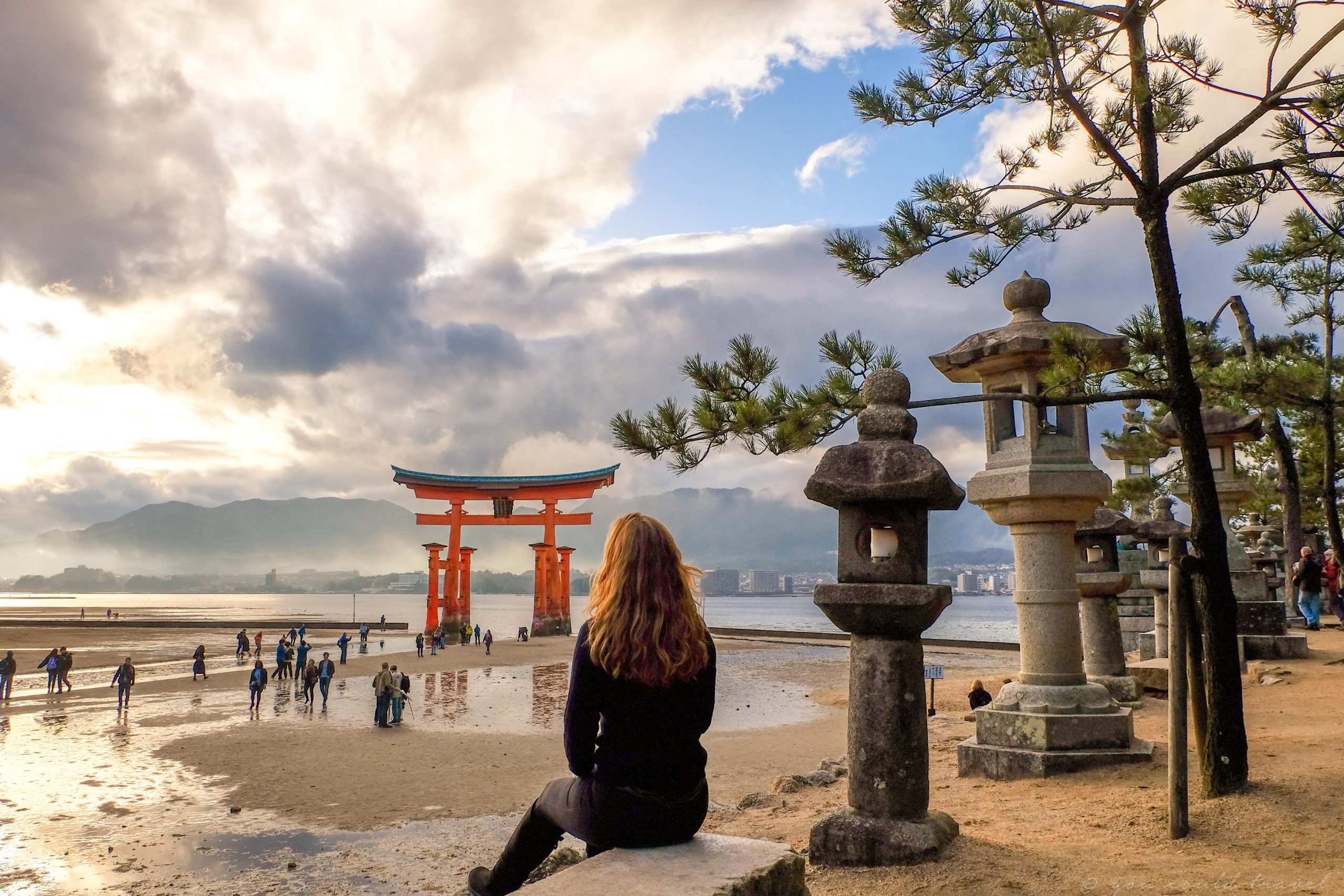
Itsukushima Shrine is a Shinto shrine on the island of Miyajima with a large vermilion torii gate which appears to be “floating” at high tide. This particular torii is so famous, it inspired many artists, including the celebrated Kawase Hasui (1883 – 1957) who created the woodblock print called “Snow at Miyajima”.
If you visit it at low tide, like I did, don’t worry, it looks just as incredible. It’s possible to walk near the base of the torii gate and explore the exposed sea floor, revealing a different perspective of the shrine and its surroundings. It’s common to see people collect shellfish near the gate during low tide, too.
In the evening, the torii is beautifully lit up by strong lights from the shore. While a gate has stood at this location since 1168, the existing structure was built in 1875.
Tip: One of the most beautiful sights of this torii is as you approach it on the ferry. Not only does it appear as if it’s floating (even at low tide!), but it has the gorgeous forested Mount Misen as backdrop, making it the perfect time for a stunning picture.
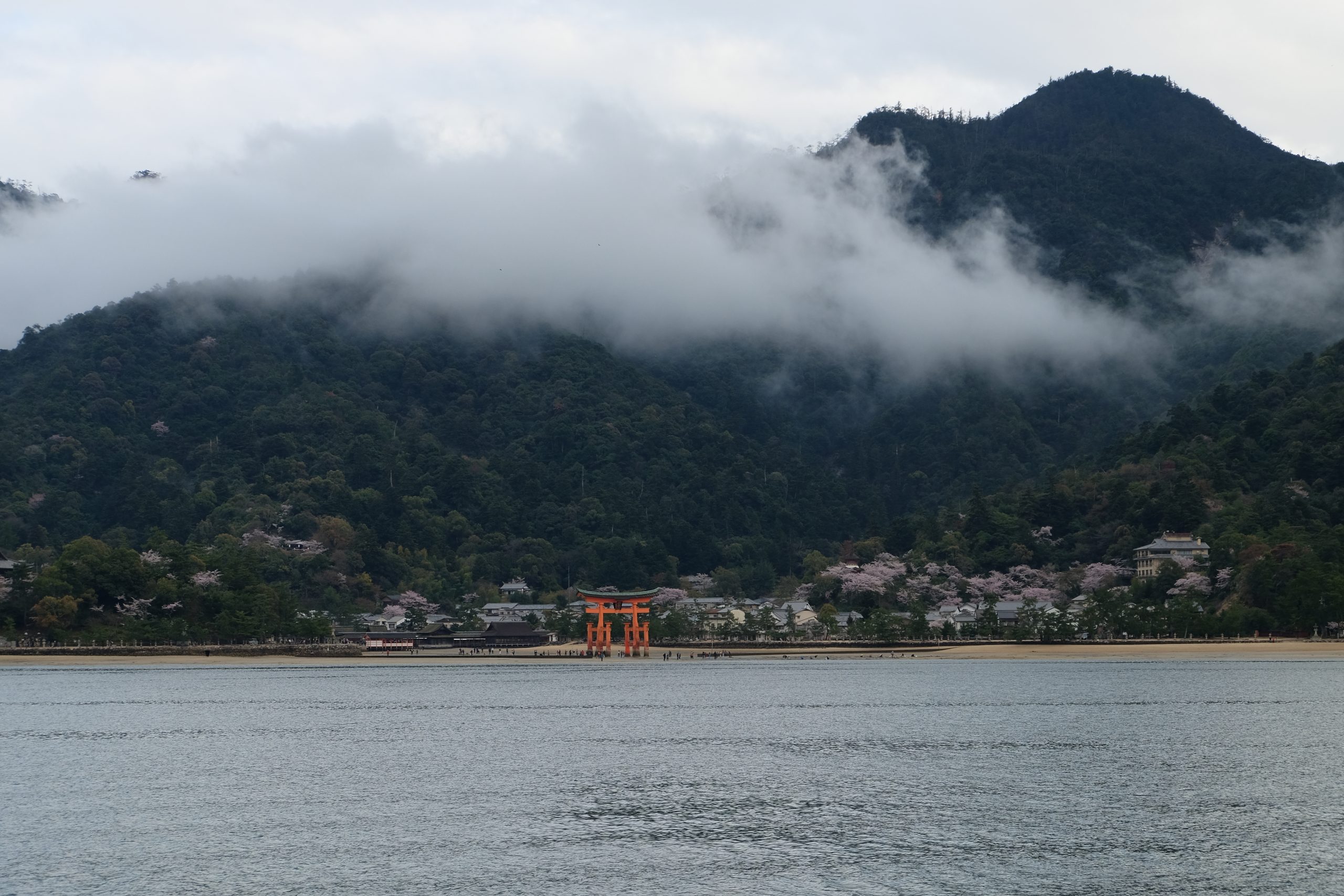
The island of Miyajima is home to sika deer, considered sacred in Japan. These Japanese deer are semi-tamed and friendly and usually come close to it in the hopes of getting some food. While visiting Miyajima, try some Momiji manjū or succulent, fresh oysters, which are a local speciality. You can hike to the top of Mount Misen or take the cable car to the summit for panoramic views of the island and the Seta Inland Sea.
Senso-ji, Tokyo
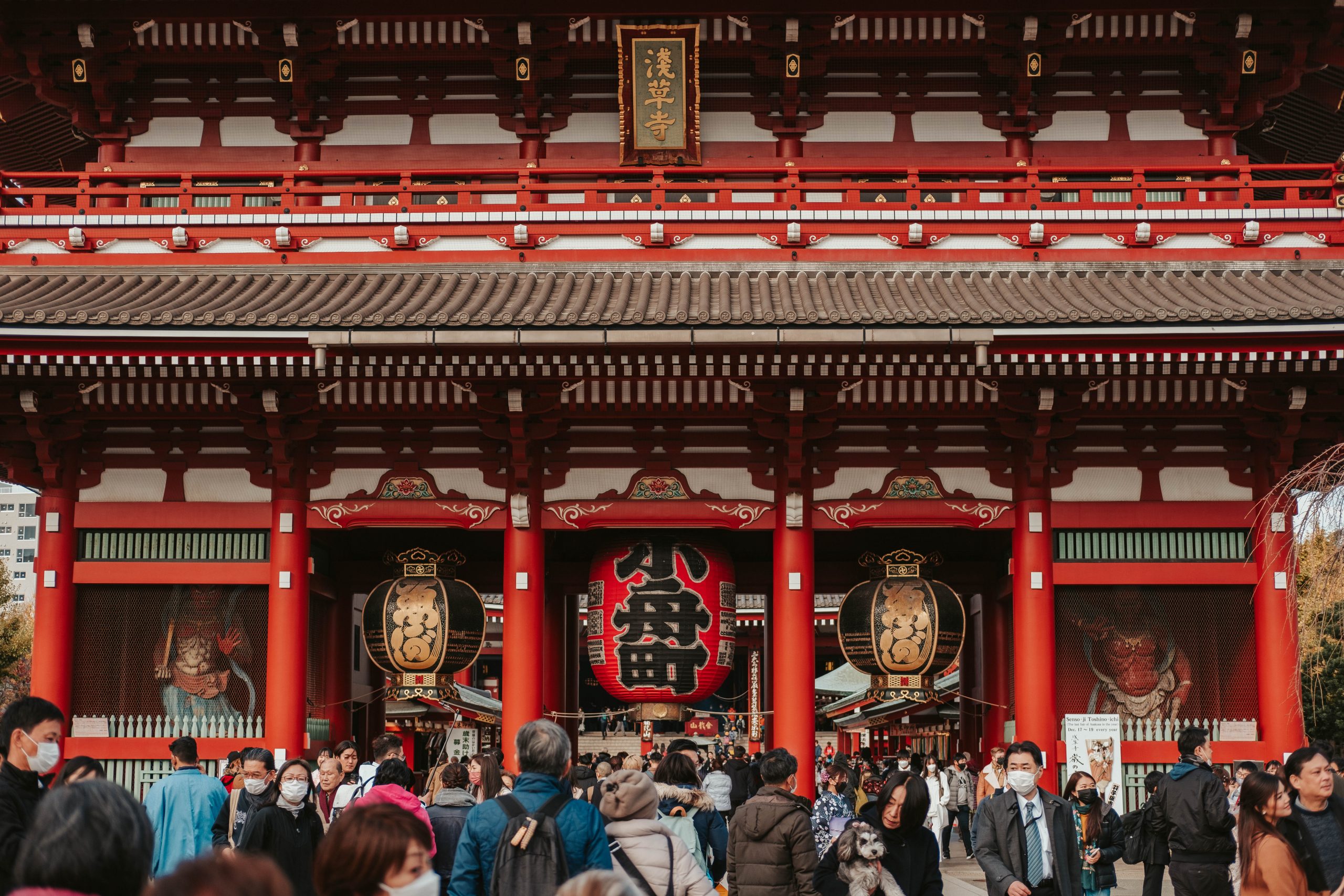
Senso-ji is Tokyo’s oldest Buddhist temple and one of the most important landmarks in the capital. Sensō is the Chinese pronunciation for Asakusa and “ji” means temple in Japanese. The literal translation for Senso-ji is Asakusa Temple. Senso-ji is in the old entertainment district of Asakusa, and it’s open 24/7 to both visitors and worshippers, although the main hall is accessible from 6:00 am to 5:00 pm.
To reach Senso-ji, you’ll first walk down Nakamise Dori, a shopping street on the temple’s approach that is ideal for finding traditional Japanese desserts and unique souvenirs. You’ll then see the imposing Kaminarimon (Thunder Gate), the impressive red gate with its lanterns and large statues of Shinto gods Fūjin and Raijin.
The temple complex has a few other structures and beautiful gardens worth exploring. Adjacent to the temple is a five-story pagoda, which is the Asakusa Shinto Shrine.
For a unique experience, Senso-ji is the perfect place to draw an omikuji, which is a Japanese fortune-telling paper strip.
Senso-ji is especially great to visit during festivals, Sanja Matsuri in May being the most popular with parades and performances. Nearby, you’ll find many attractions too, like the Tokyo Skytree, the Sumina River for cruises and the Kappabashi Street for ceramics and traditional kitchen wear.
Kinkaku-ji, Kyoto
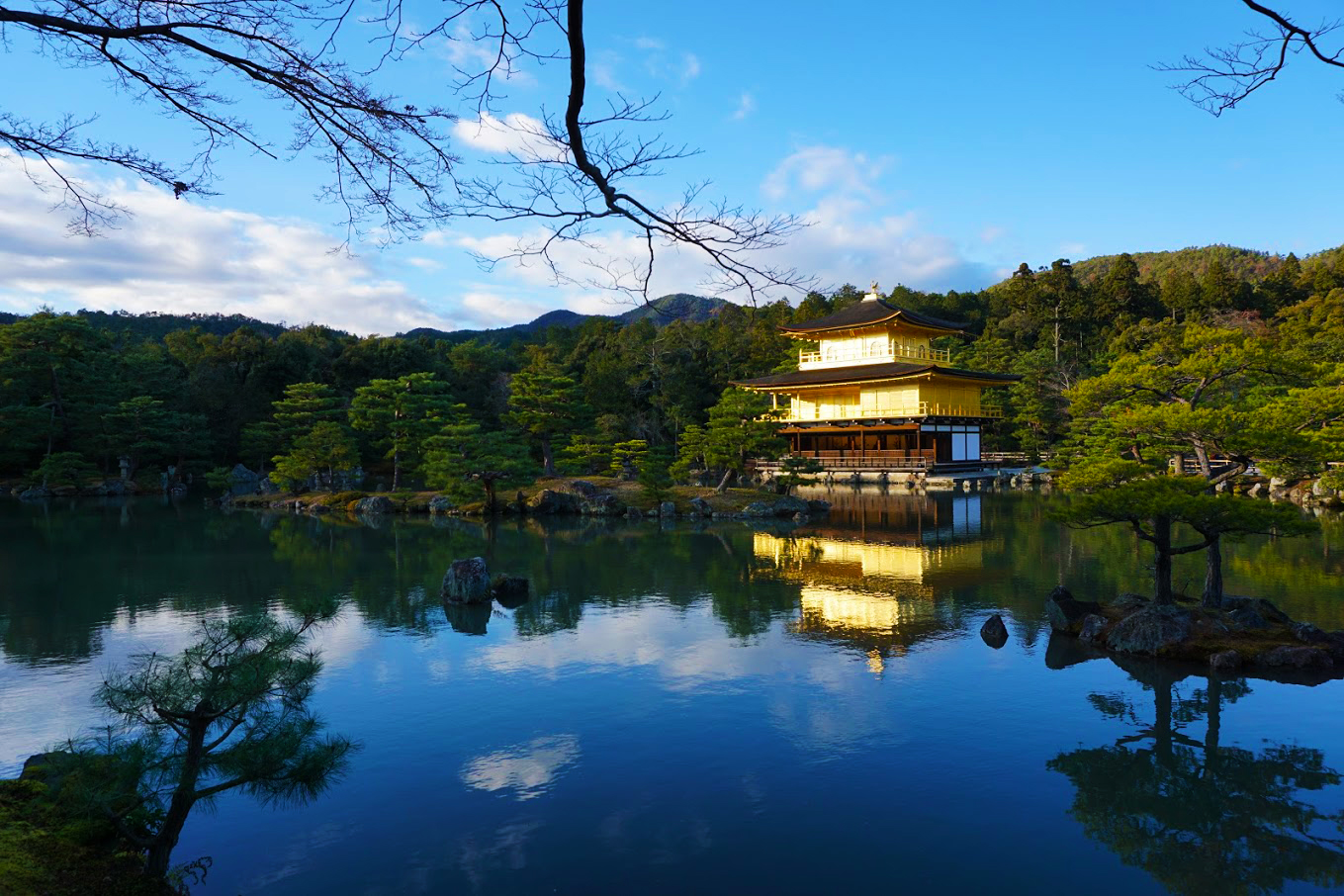
Kinkaku-ji or the Temple of the Golden Pavilion, is a Zen Buddhist temple in Kyoto with its top two floors covered in gold leaf. The sight is truly magnificent as the temple reflects beautifully in the mirror pond situated directly in front of it called Kyōko-chi (鏡湖池), or Mirror Pond. If you’ve seen postcards of Kinkaku-ji, I guarantee that it looks just the same in real life.
The temple is a designated UNESCO World Heritage Site and an important part of Kyoto’s historical and cultural landscape. It’s so beautiful and popular, don’t be surprised if you see long queues of people patiently waiting to take the same picture. Don’t worry though, the lines go fast, and it’s very well managed, so everyone gets to enjoy it equally.
After you’ve taken all the photos of Kinkaku-ji, spend some time admiring the beautifully maintained landscaped gardens around it. The garden has elements from the Muromachi period, where a minimalistic approach was brought to the Japanese garden design.
Behind the pavilion, the path leads you to another water pond, the Anmintaku Pond, featuring a small island with a mini stone pagoda.
Kinkaku-ji can be easily accessed by public transportation. From Kyoto Station, you can take the Kyoto City Bus number 101 or 205 and get off at the Kinkaku-ji Michi bus stop. The temple is just a short walk from the bus stop.
Himeji castle, Himeji
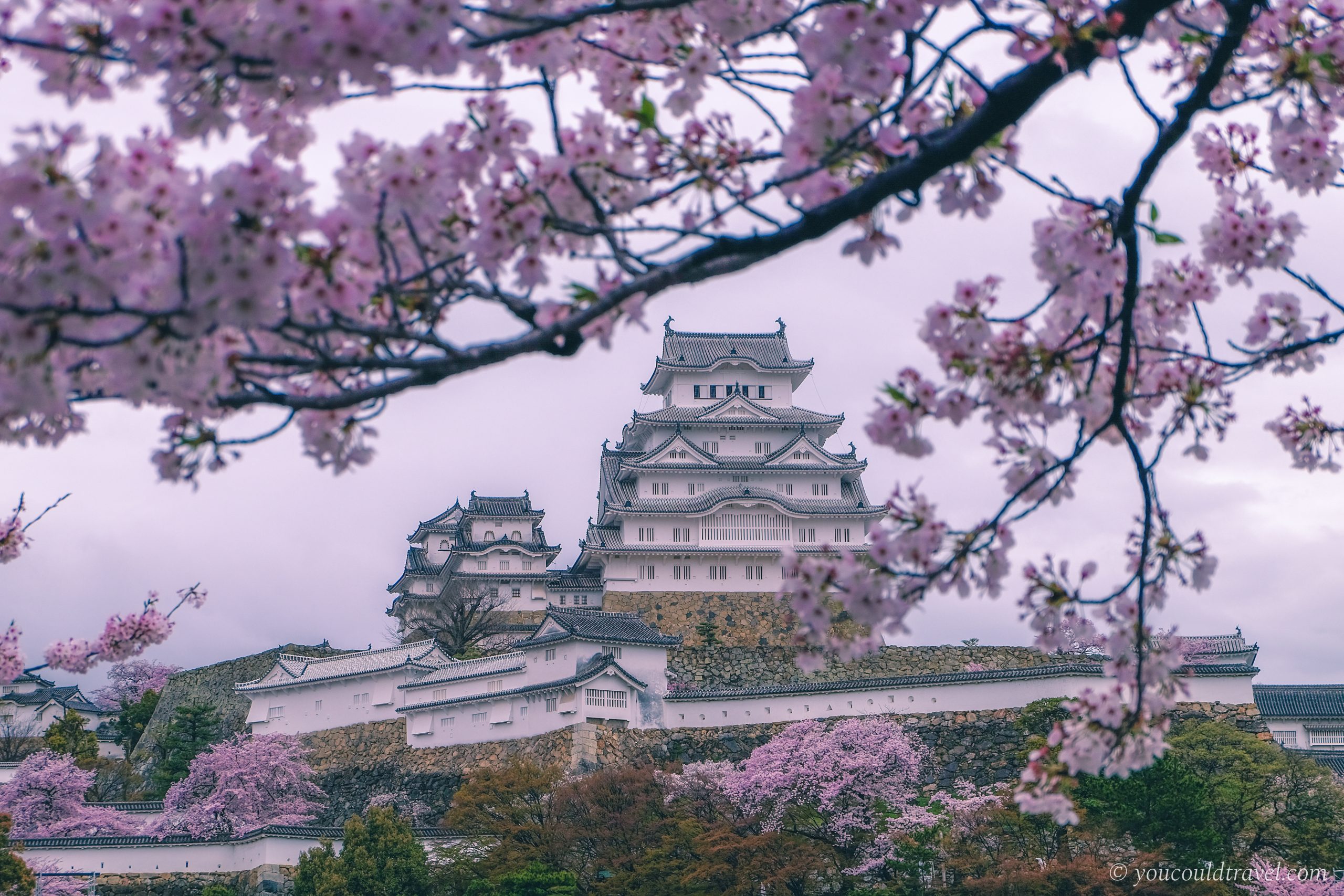
Himeji Castle is one of the most iconic, well-preserved castles in Japan. It is described as “White Heron Castle” because of its elegant, white exterior resembling a heron in flight. Himeji Castle is also a stunning example of a Japanese castle design created to ward off enemies. In fact, Himeji Castle has 83 buildings with highly developed systems of defence in place.
Himeji Castle holds great historical and cultural significance in Japan. It played a crucial role in Japan’s feudal history, serving as a strategic fortress and a symbol of power and authority. It survived wars, natural disasters, and urban development.
The castle’s surrounding area features wonderful Japanese gardens with plenty of cherry trees. Himeji Castle looks especially wonderful during the cherry blossom season. When visiting Himeji Castle, make sure to wear comfortable shoes as you will need to climb multiple flights of stairs and levels.
Nearby attractions include the gorgeous Koko-en gardens and the Engyoji Buddhist Temple.
To reach Himeji Castle, you can take advantage of the extensive Japan Rail network (and use your Japan Rail Pass). From Osaka or Kyoto, simply board a JR Shinkansen (bullet train) bound for Himeji Station.
Hiroshima Peace Memorial, Hiroshima
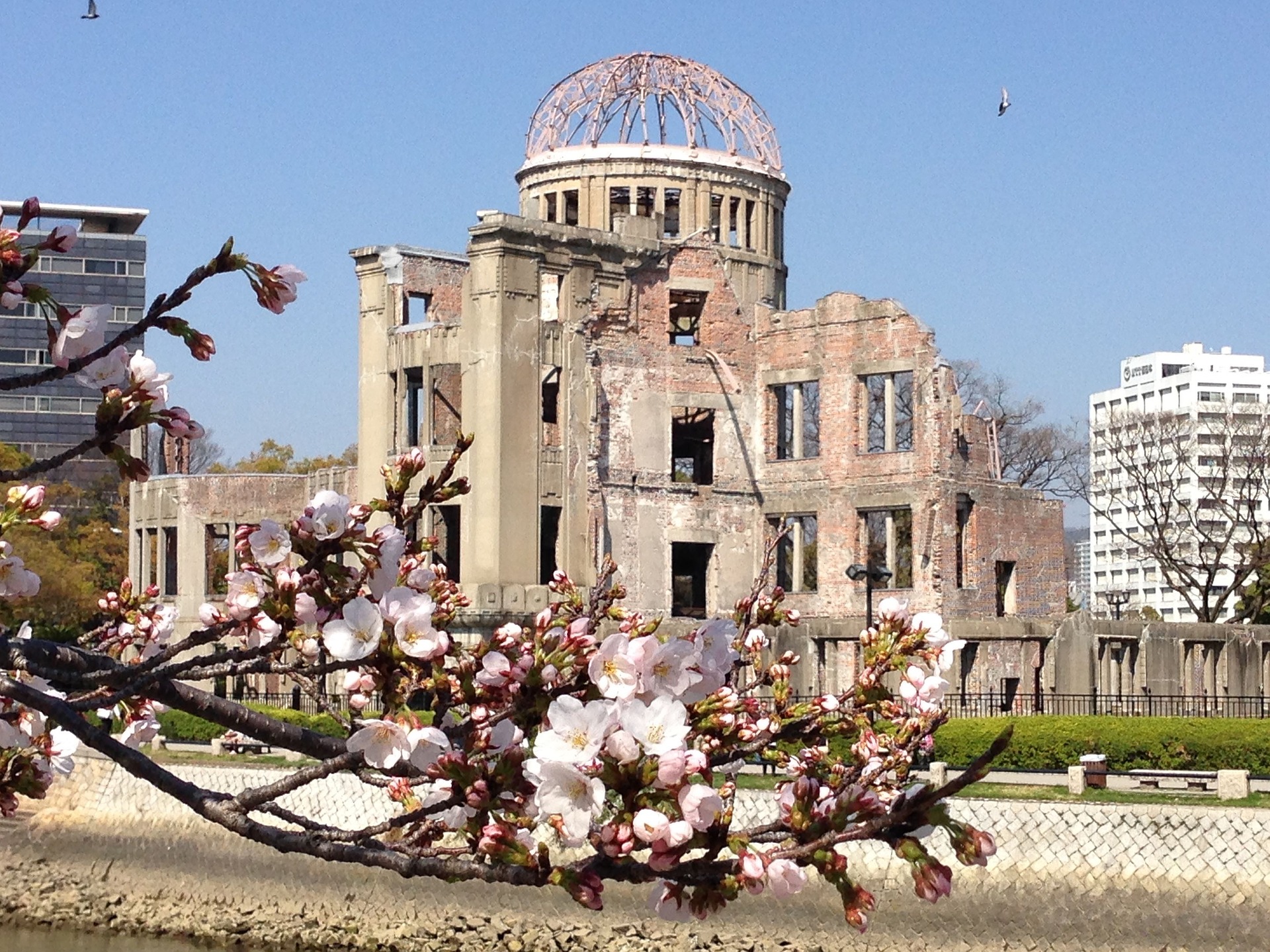
The Hiroshima Peace Memorial (Atomic Bomb Dome) is the skeleton of the former Promotion Hall which remained standing despite the devastation caused by the first atomic bomb. The Hiroshima Peace Memorial was purposely left as is, to act as a reminder of the tragic events that unfolded on August 6, 1945. The building is a symbol of peace and humanity’s hope for a world free from nuclear weapons.
The Hiroshima Peace Memorial was designated a UNESCO World Heritage Site in 1996. Surrounding the Atomic Bomb Dome is the Hiroshima Peace Memorial Park, home to several monuments and memorials, including the Children’s Peace Monument, the Peace Flame, and the Hiroshima Peace Memorial Museum.
Allocate sufficient time to explore the park, visit the museum, and engage in quiet contemplation and do note that some exhibits include personal artefacts, photographs, and accounts from survivors (known as hibakusha) and seeing these can trigger intense emotions.
Hiroshima is very well-connected by public transport, and the Atomic Dome is located close to the Genbaku Dome-mae tram station. Hiroshima is a popular city with tourists and has plenty of great accommodation options to suit all budgets.
Meiji Shrine, Tokyo
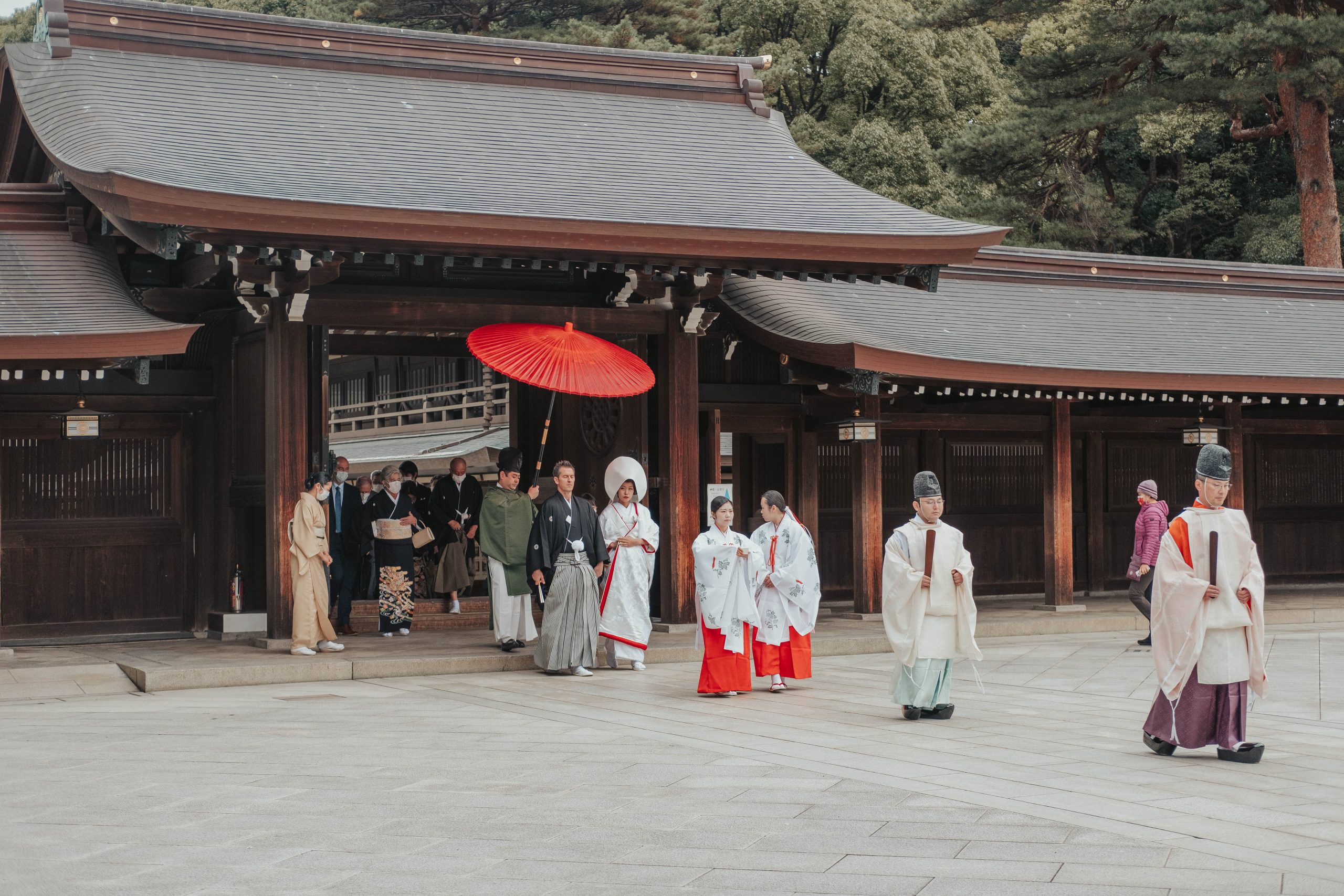
Meiji Shrine, or Meiji Jingu, is a famous Shinto shrine located in a large and beautiful forest in the Shibuya district. The shrine is dedicated to Emperor Meiji and his wife, Empress Shoken, who played pivotal roles in Japan’s modernization during the Meiji Restoration.
The entrance to Meiji Shrine is defined by the large wooden torii made of cypress wood. You’ll walk along the gravel pathway and surrounded by 120,000 trees. Around the main hall, it’s not uncommon to see traditional Japanese weddings.
Meiji Shrine is adjacent to Yoyogi Park, a popular forested park, especially popular during hanami. The entrances open at sunrise and close at sunset.
A great time to visit Meiji Shrine is during the first few days of the new year, when the shrine hosts traditional Shinto ceremonies and attracts large crowds for Hatsumode, the first shrine visit of the year.
Nearby accommodations in Tokyo offer a wide range of options to suit different preferences and budgets. As Meiji Shrine is centrally located, it is easily accessible by public transportation, including subway and train lines to the Meiji-jingumae ‘Harajuku’ Sta. The shrine is frequently included in Tokyo itineraries due to its historical significance.
Gion District, Kyoto
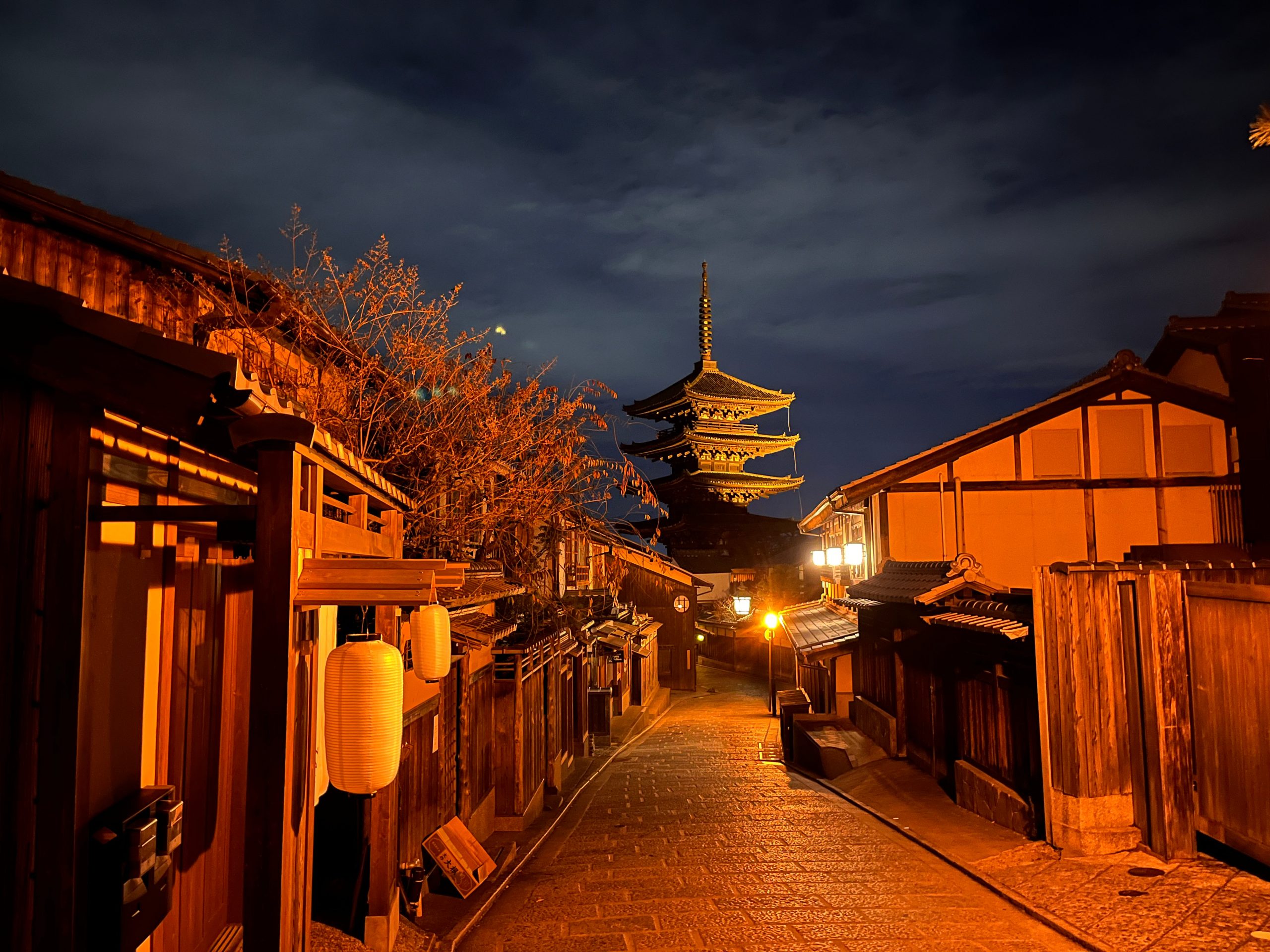
One of the most famous landmarks in Japan is the historical and culturally rich Gion District in Kyoto. The Gion District is celebrated for its well-preserved traditional architecture, stone-paved streets, and wooden machiya town houses decorated with traditional lanterns and norens. Gion is also Kyoto’s most iconic geisha district, and one of the main attractions is the possibility of encountering a geisha (or maiko).
Geishas are skilled performers who entertain guests with music, dance, and conversation. Many Geisha learn how to play games and can even speak English. The most beautiful street is the Hanamikoji Street, lined with ochaya (tea houses), traditional restaurants and exclusive establishments where geisha entertain guests.
Some of the best kaiseki restaurants will be here in the Gion district. Nearby, you will find the Gion Corner, a cultural centre where you can experience traditional performing arts such as tea ceremonies, flower arrangement (ikebana), koto music, and traditional puppet theater (bunraku).
Gion hosts several festivals and events throughout the year, but the most important is the Gion Matsuri, a month-long festival held in July, featuring elaborate processions, floats, and traditional performances that attract both locals and tourists. In Gion you’ll find beautiful shrines and temples, including the Yasaka Shrine.
Gion is a great place to stay in Kyoto, as you can rent all sorts of ryokans or modern hotels.
Dotonbori, Osaka
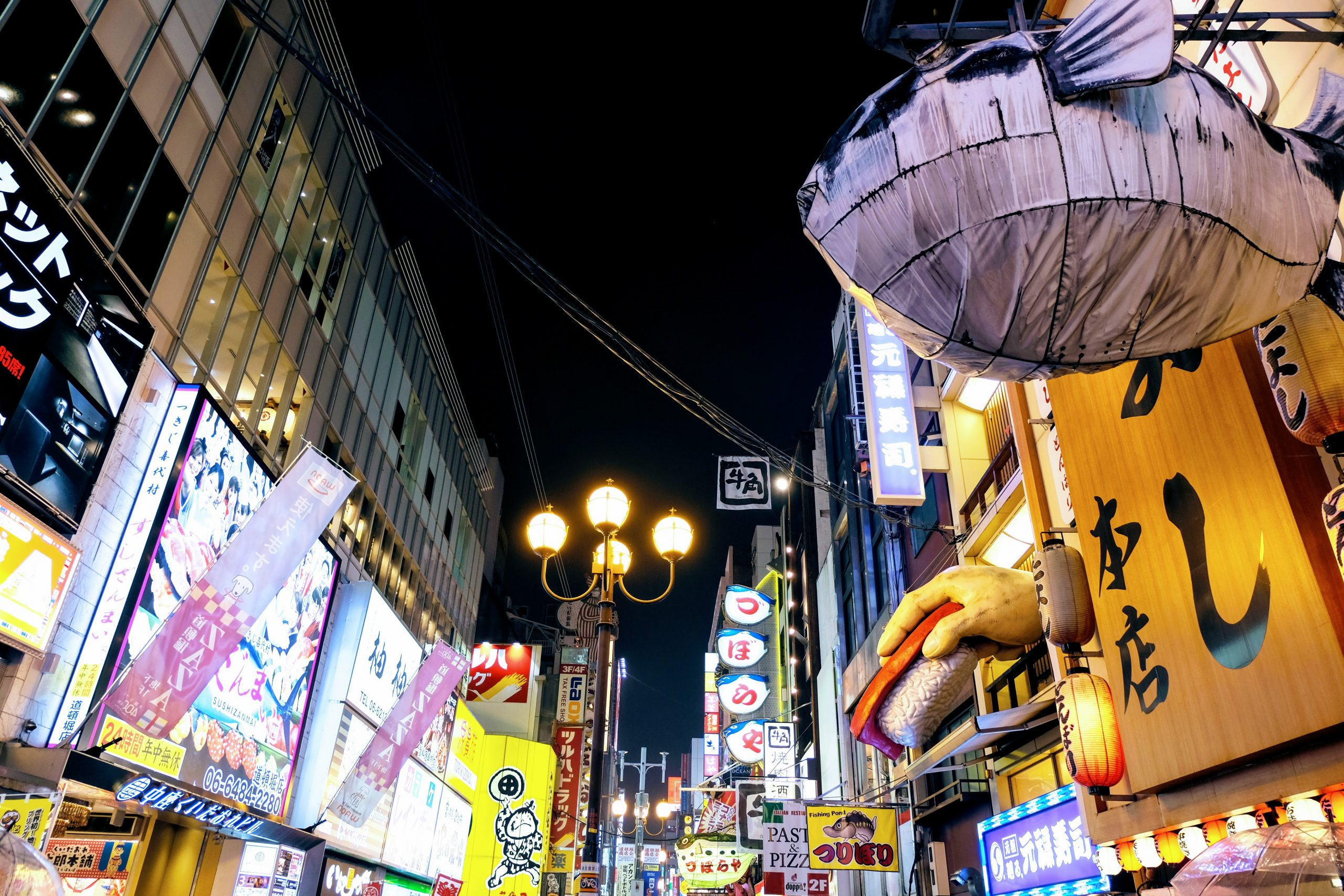
Dotonburi is the entertainment district in Osaka where you’ll be surrounded by neon lights, large mascots, and awesome restaurants.
Dotonbori is an important destination for food lovers in Osaka because it has a reputation as the “nation’s kitchen”. Dotonbori is associated with the term “kuidaore”. Kuidaore, written as 食い倒れ in Japanese, translates colloquially, “eating until you drop”. It’s best known from the proverb that translates to “Dress extravagantly in Kyoto, eat extravagantly in Osaka”.
And honestly, there is so much food to be enjoyed here. Try takoyaki (octopus-filled batter balls), okonomiyaki (savory Japanese pancakes), kushikatsu (deep-fried skewered meats and vegetables), and yakiniku (grilled meat).
Don’t miss the famous Glico sign, which features the iconic image of a runner crossing the finish line with arms raised in triumph. This ad for the confectionery company Glico has become synonymous with the district.
Another iconic feature of Dotonbori is the Ebisu-bashi Bridge, which spans the Dotonbori Canal. This bridge is brilliant for photos after dark. Nearby, you’ll find the Shinsaibashi Shopping arcade, which is a covered pedestrian street and connected to Dotonbori.
Dotonbori is one of the best places to stay in Osaka for first time visitors. It’s a great area with plenty of hotels ranging from budget to luxury accommodation. Dotonbori is a great area not just for nightlife, but it’s very well-connected with the rest of Osaka too.
Shirakawa-go, Gifu
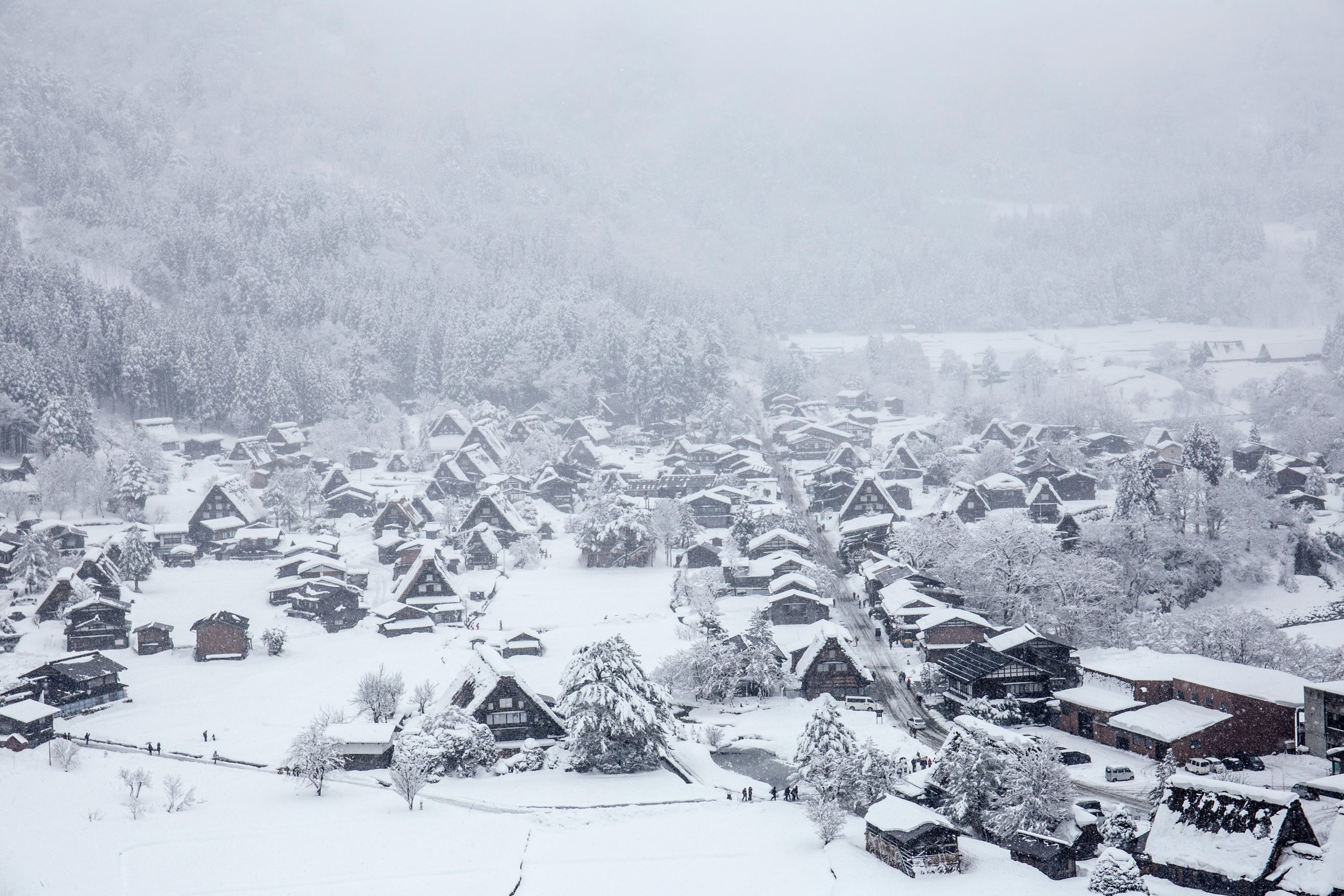
Shirakawa-go is a small traditional Japanese village in the mountainous region of Gifu Prefecture. The village is a famous Japan landmark known for its traditional gassho-zukuri farmhouses, which feature steep thatched roofs resembling hands in prayer (hence the name gassho, meaning “praying hands” ) designed to withstand heavy snowfall. Shirakawa-go is a designated UNESCO World Heritage Site, celebrated for its unique architectural style.
Shirakawa-go is beautiful throughout the year, but during winter, the village is transformed into a snowy wonderland. The annual illumination event, called Shirakawa-go winter light up, is held from January to February.
Apart from the village itself, you can explore the mountainous region with its forested hiking trails. There isn’t much accommodation in Shirakawa-go, but you can easily stay in either Nagoya, Kanazawa, or Takayama, then use the public transport to reach the village as a day trip.
Osaka Castle, Osaka
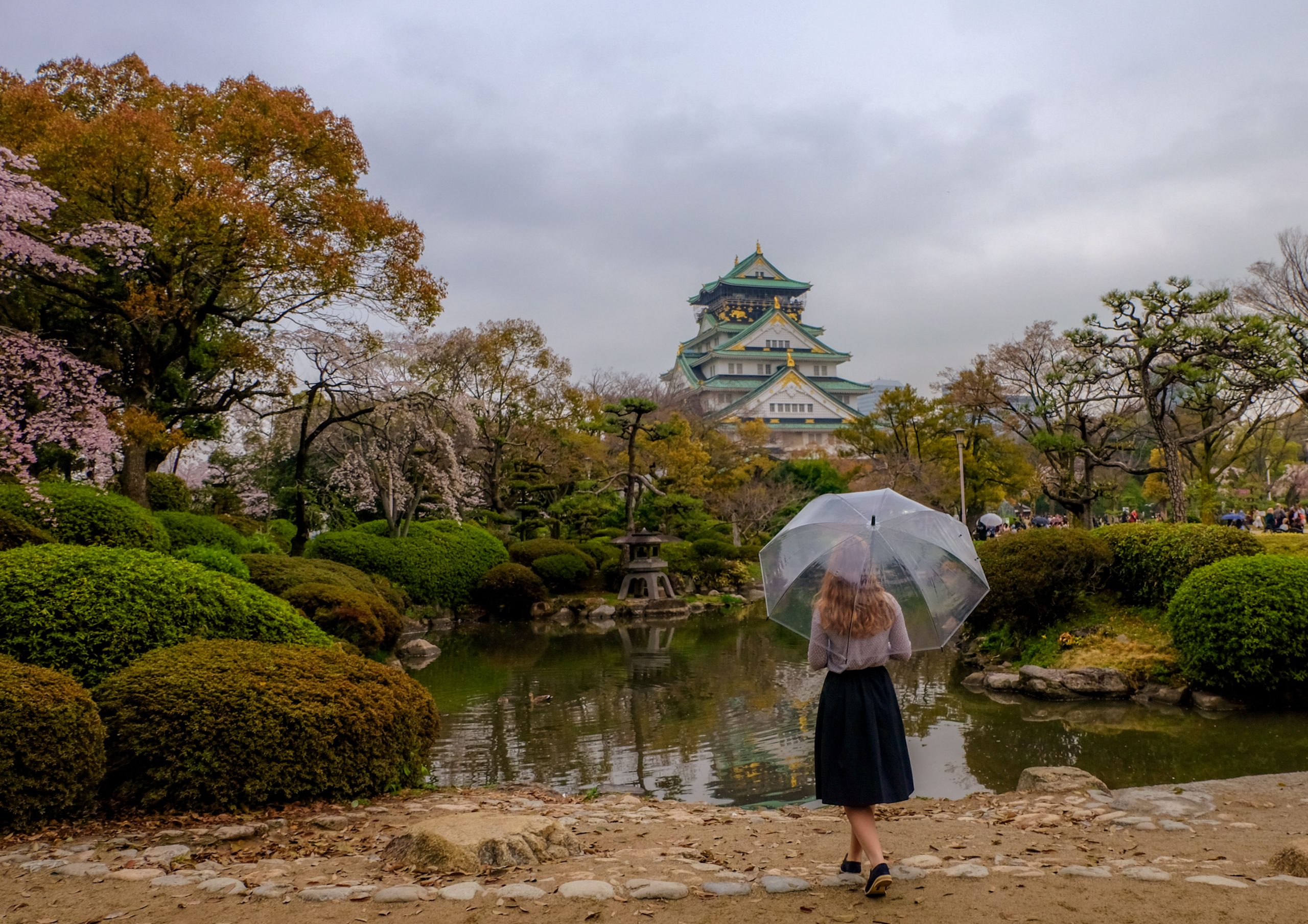
Osaka Castle is an important landmark in Japan, originally constructed in the 16th century by Toyotomi Hideyoshi, a prominent samurai warrior and ruler during the Sengoku period. The current building you see and visit today was rebuilt in 1931.
Osaka Castle features a towering five-story exterior covered in white plaster with golden accents. The interior of the castle is now a museum where you can learn about the castle’s history. Climb the stairs (or take the elevator) up the main tower to see beautiful panoramic views of Osaka.
When visiting the Osaka Castle, make sure to allocate some time for exploring the castle grounds with its beautiful gardens and moats. There is even a shrine within the castle grounds called Hokoku Shrine. The Osaka Castle is very popular for hanami season as it’s surrounded by beautiful cherry trees.
Todai-ji Temple, Nara
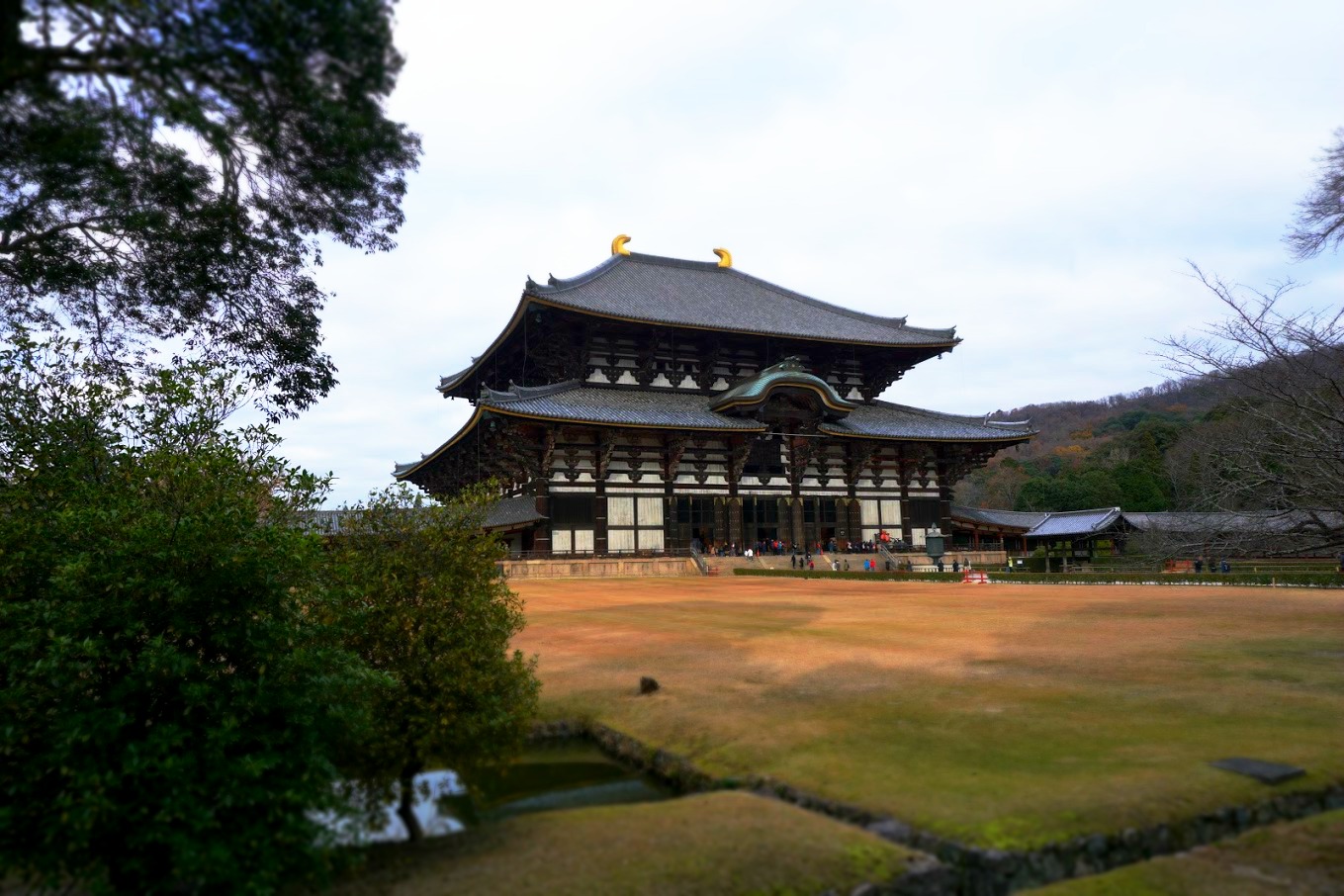
Todai-ji Temple is an 8th century Buddhist temple in Nara, famous for its Great Buddha Hall (Daibutsuden), which houses one of the world’s largest bronze Buddha statues and the largest in Japan. The Great Buddha Hall is one of the world’s largest wooden buildings, which has been rebuilt twice due to fires. Inside, you will marvel at the Great Buddha (Daibutsu), which is a 15-meter tall statue of Vairocana Buddha.
The temple complex also includes the Nandaimon Gate, guarded by two statues known as Nio, protectors of Buddhism. Make sure to visit the Todai-ji Museum, next to the Great Buddha Hall, which displays Buddhist art and artefacts and provides information about the temple’s history and its cultural significance.
The temple complex is located in Nara Park, a green space where you can interact with the local sika deer, considered messengers of the gods in the Shinto religion. You’ll notice that these semi-tamed deer learnt how to bow to you in the hopes that they will get more food. To feed them deer biscuits, purchase a pack from any authorised vendor in the park.
Nara is also home to other famous temples and shrines like Kofuku-ji and Kasuga Taisha Shrine, which are worth visiting.
Nara is less than an hour away from both Kyoto and Osaka by train, making it an ideal destination for a day trip.
Tokyo Tower, Tokyo
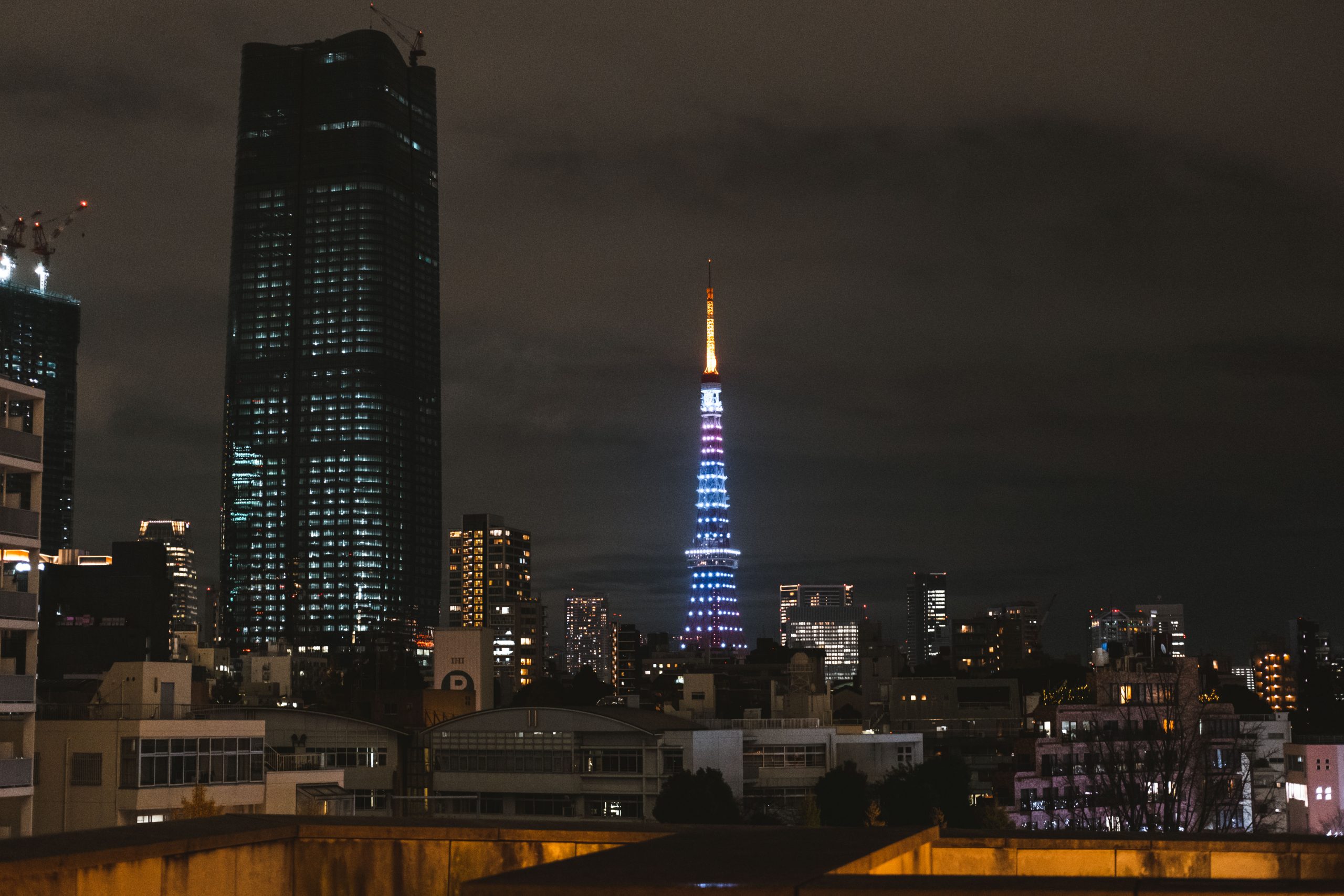
Tokyo Tower is an iconic landmark in Tokyo and a symbol of the city which offers great panoramic views of the city. The Tokyo Tower was completed in 1958 and stands at 333 meters (1,093 feet) tall, originally inspired by the Eiffel Tower in Paris.
The primary functions of Tokyo Tower is as a broadcasting tower for television and radio signals. But it has also evolved into a popular tourist destination thanks to its two observation decks. The Main Observatory is located at 150 meters (492 feet), while the higher Top Observatory stands at 250 meters (820 feet). On clear days, you can see as far as Mount Fuji.
Beyond climbing to the top of Tokyo Tower, there’s plenty to do within its premises. Check out the FootTown, located at the base of the tower, is a four-story building housing shops, restaurants, and even a theme park called One Piece, based on the main characters of the Straw Hat Crew.
For those interested in the tower’s history and construction, there is the Tokyo Tower Wax Museum and the Guinness World Records Museum, which showcase exhibits related to the tower’s development and notable achievements.
Tokyo Tower is especially beautiful at night, when it’s beautifully illuminated. The lighting design changes throughout the year, and there are many places in Tokyo where you can admire it from as close or as far as you desire. For example, the rooftop at Mori Tower is a magnificent place for night photography, with the Tokyo skyline and the Tokyo Tower.
Tokyo Tower can be easily accessed from Roppongi. To avoid long queues, I do recommend that you get tickets in advance to save some time.
Tokyo Skytree, Tokyo
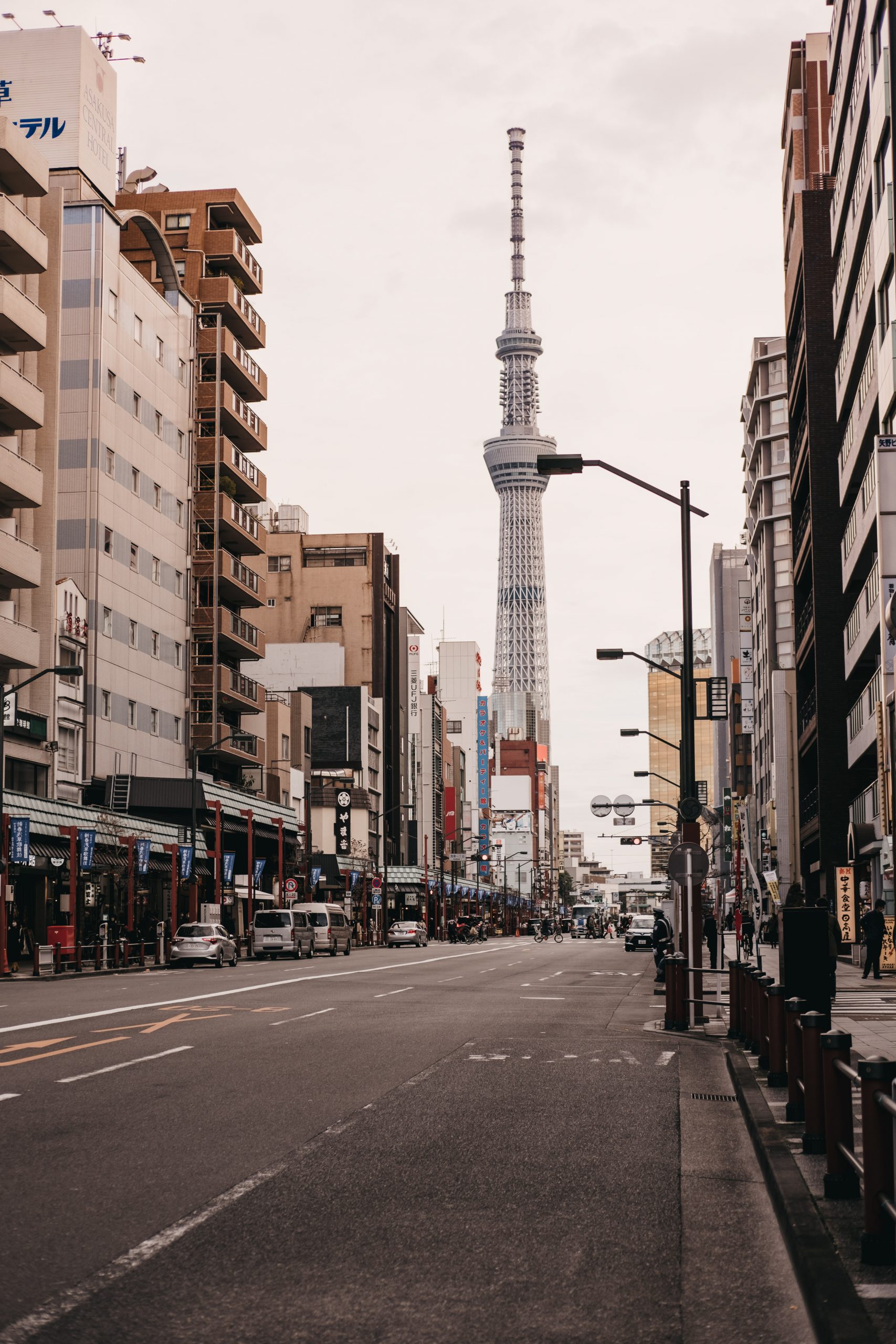
Tokyo Skytree is Japan’s tallest tower and the world’s tallest freestanding broadcasting tower, standing at an impressive 634 meters (2,080 feet). In fact, it’s the tallest tower in the world since 2011. The Tokyo Skytree has two observation decks at 350 meters (1,148 feet) and 450 meters (1,476 feet). Both decks offer unobstructed views of Tokyo’s skyline.
At the base of Tokyo Skytree, there is a large commercial complex called Tokyo Solamachi. This complex features shops, restaurants, cafés, and entertainment facilities. One of the most popular shops here is the Donguri Republic, which is a Ghibli Store.
For photography enthusiasts, it is worth noting that tripods, and large camera equipment are not permitted on the observation decks. You can bring in smaller cameras and smartphones.
Just like the Tokyo Tower, the Tokyo Skytree is beautifully illuminated at night with vibrant lighting schemes that change depending on the season and special occasions.
Tokyo Skytree is located near Oshiage Station, which is accessible via multiple train lines.
Nikko Toshogu Shrine, Tochigi
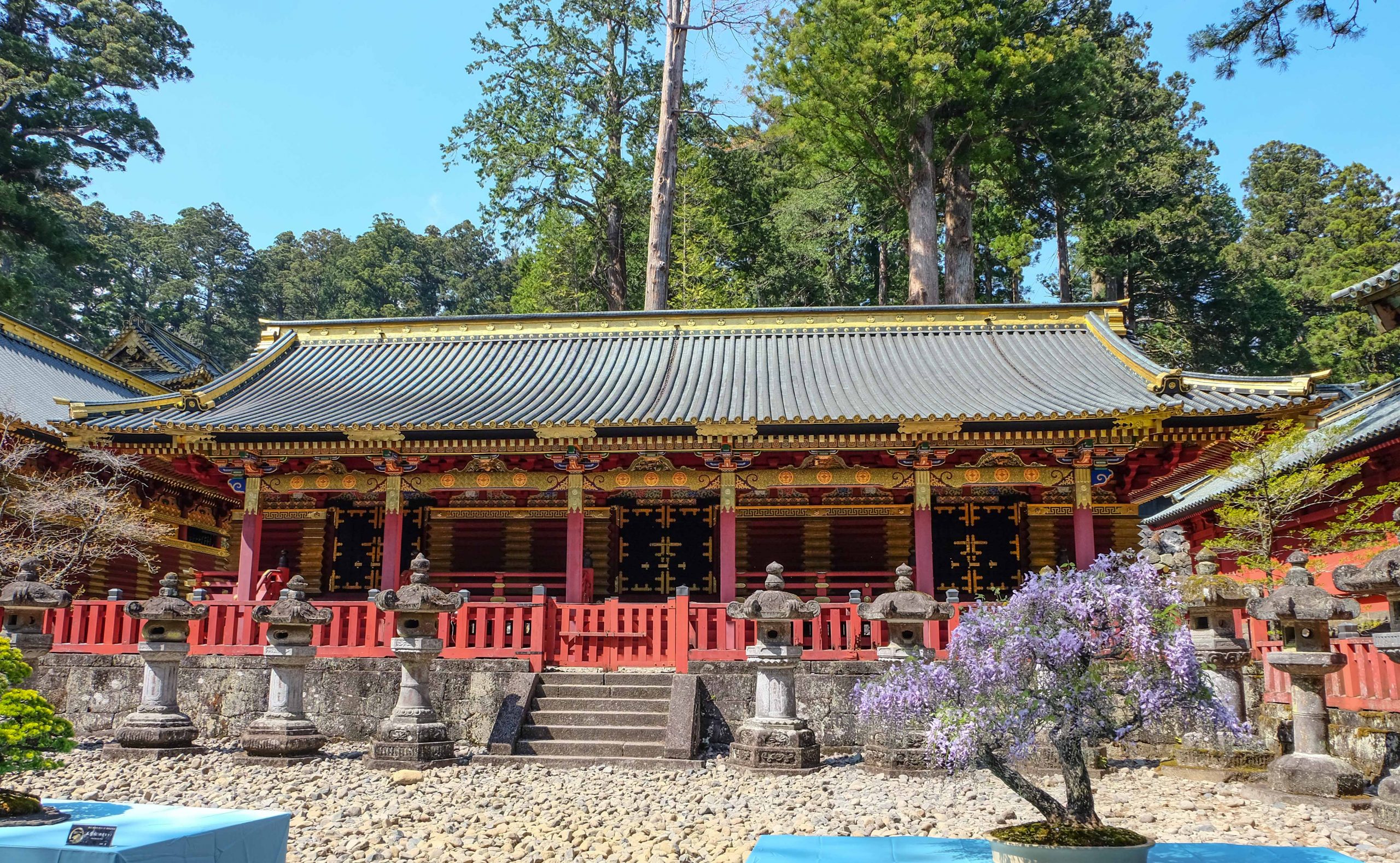
Nikko Toshogu Shrine is a lavishly decorated shrine dedicated to Tokugawa Ieyasu, the founder of the Tokugawa Shogunate. The shrine is located in the city of Nikko, nestled within the picturesque mountains of Tochigi Prefecture.
Nikko Toshogu Shrine was constructed between 1617 and 1636, and it has elements of both Buddhism and Shintoism. The shrine’s main hall, the Yomeimon Gate, has many intricate carvings depicting all sort of mythical creatures. The Sacred Stable has the famous carvings of the Three Wise Monkeys.
The shrine complex also includes the ornate Honden, the Karamon Gate, Shimojinko Shrine, and Futarasan Shrine.
There are many attractions around Nikko Toshogu Shrine, including the vermilion Shinkyo Bridge. Also in Nikko, you will find the beautiful Kegon Falls. The water of the Kegon Falls originates from Lake Chuzenji, which is the highest natural lake in the country. It plunges down in a magnificent waterfall, dropping 97 meters, and forms a picturesque rocky plunge pool enveloped by lush green vegetation.
Many take a day trip to Nikko to see the main highlights of the city, including the spectacular Nikko Toshogu Shrine. To reach Nikko Toshogu Shrine, you can take a train from Tokyo to Nikko. From Tobu-Nikko Station, the shrine is a 30-minute walk or a short bus ride away.
The best time to visit Nikko Toshogu Shrine is during autumn, when the surrounding mountains have colourful autumn leaves.
Naoshima, Kagawa
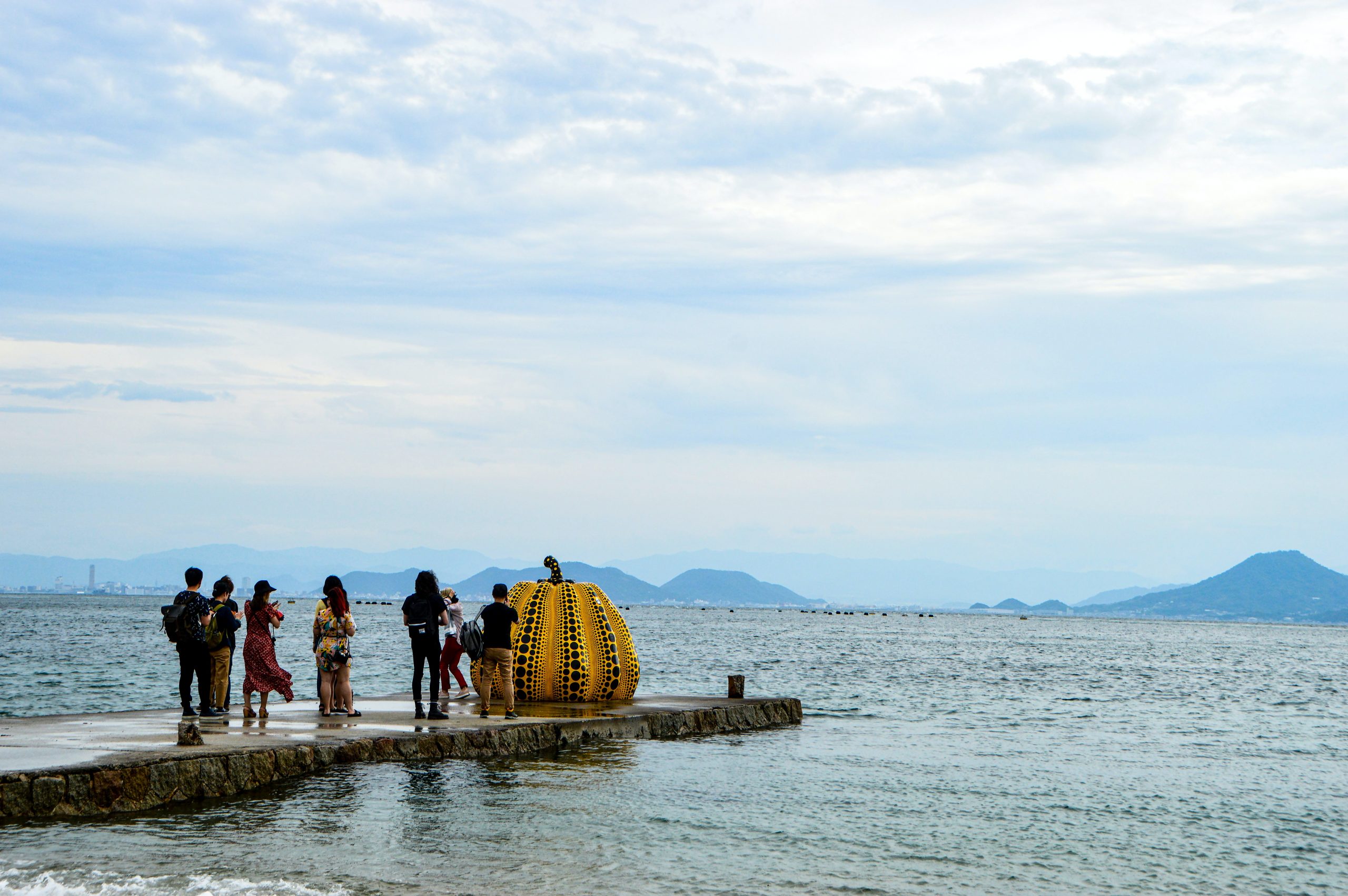
Naoshima is an island off the coast of Tamano city, located in southern Okayama Prefecture. Naoshima is very popular with art lovers, thanks to its multitude of art museums, sculptures, and installations.
Sometimes called the Art Island, Naoshima is home to Yayoi Kusama’s iconic yellow pumpkin sculpture. The pumpkin has been a recurring symbol in Kusama’s art since her childhood, representing a sense of comfort and familiarity to the artist. The sculpture is vivid yellow with black polka dots.
To explore the island, you will want to rent a bike and cycle your way around the island. Depending on how long you have to explore Naoshima, you can pick a day route or an overnight route that takes you around museums and art houses.
You won’t want to miss the Chichu Art Museum and the Benesse House Museum, both designed by Tadao Ando. Chichu Art Museum is built mostly underground and utilizes natural light to illuminate its collection of artworks. Benesse House Museum is both a museum and a hotel.
Aside from art, Naoshima is a great island for cycling and walking, with many beautiful scenic points.
Tokyo Imperial Palace, Tokyo
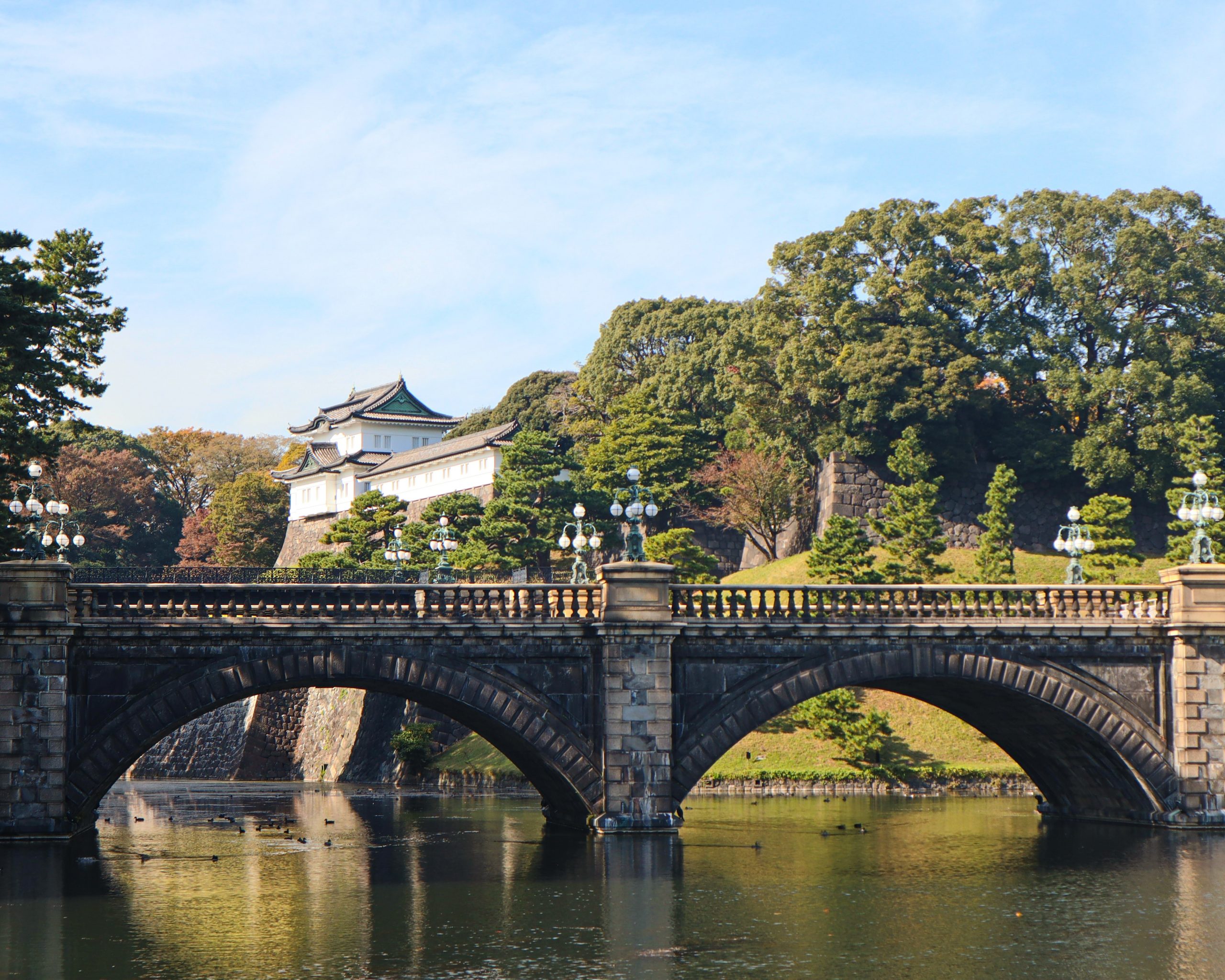
Tokyo Imperial Palace (Kōkyo) is one of the most famous landmarks in Japan due to its historical, cultural, and political significance. The palace is the primary residence of the Emperor of Japan and the Imperial Family, which is the world’s oldest hereditary monarchy.
The Imperial Palace covers a vast area and while the palace itself cannot be accessed by the public, the East Gardens are open year round for visitors. These gardens have beautiful Japanese gardens and a moat with historical remnants of the Edo Castle.
Admire the Otemon Gate which marks the entrance to the gardens and the Nijubashi Bridge, a double-arched stone bridge leading to the inner palace grounds, one of the most recognizable landmarks in Tokyo, often associated with the palace.
The Imperial Palace is located in within the Chiyoda ward, and it’s easily accessible by public transport. Nearby you will find the main Tokyo Station, as well as the Marunouchi Building and Kitte Building, all fantastic options for shopping and food.
Kōtoku-in, Kanagawa
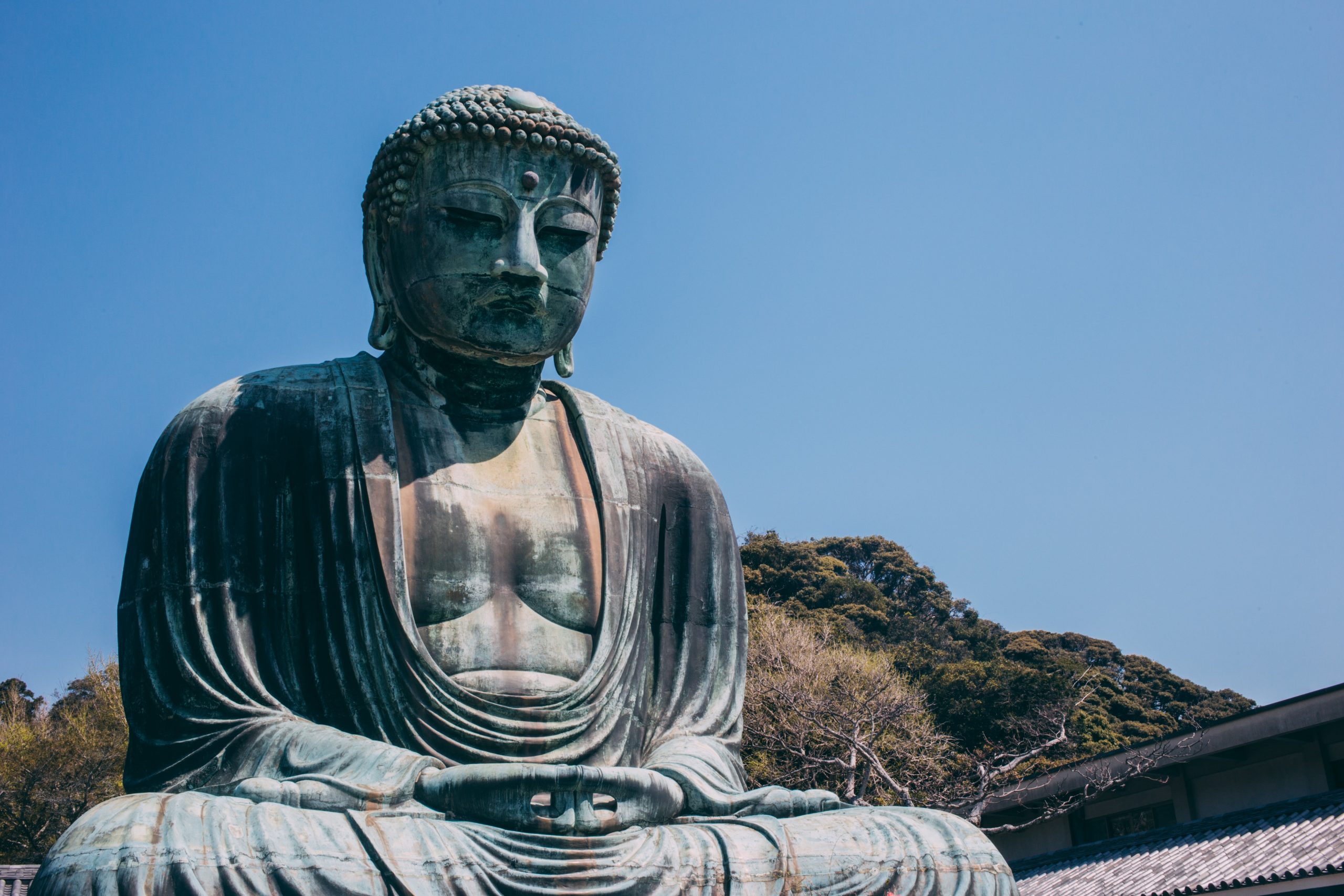
Kōtoku-in is a temple in Kamakura which houses a large Daibutsu or Great Buddha. This huge bronze statue of Amida Buddha built in the 13th century is one of the most famous in Japan. It’s 13.35 metres (43.8 ft) tall and weighs around 121 tons, making it the second-largest bronze Buddha statue in Japan, following the one in Nara’s Todai-ji Temple.
This collosal statue was originally housed in a wooden temple hall, but the structure was destroyed by a series of natural disasters in the 14th and 15th centuries. The Great Buddha has since been left in the open air and has withstood the test of time, weathering the elements. For about ¥20 you can enter the statue to learn about its history.
Kamakura itself is a historic city with numerous temples and shrines, so nearby you will find the Kamakura Hasedera Temple and the beautiful Sasuke Inari Shrine.
Kamakura is easily accessible from Tokyo by train, making it a popular day trip destination.
Jigokudani Monkey Park, Nagano
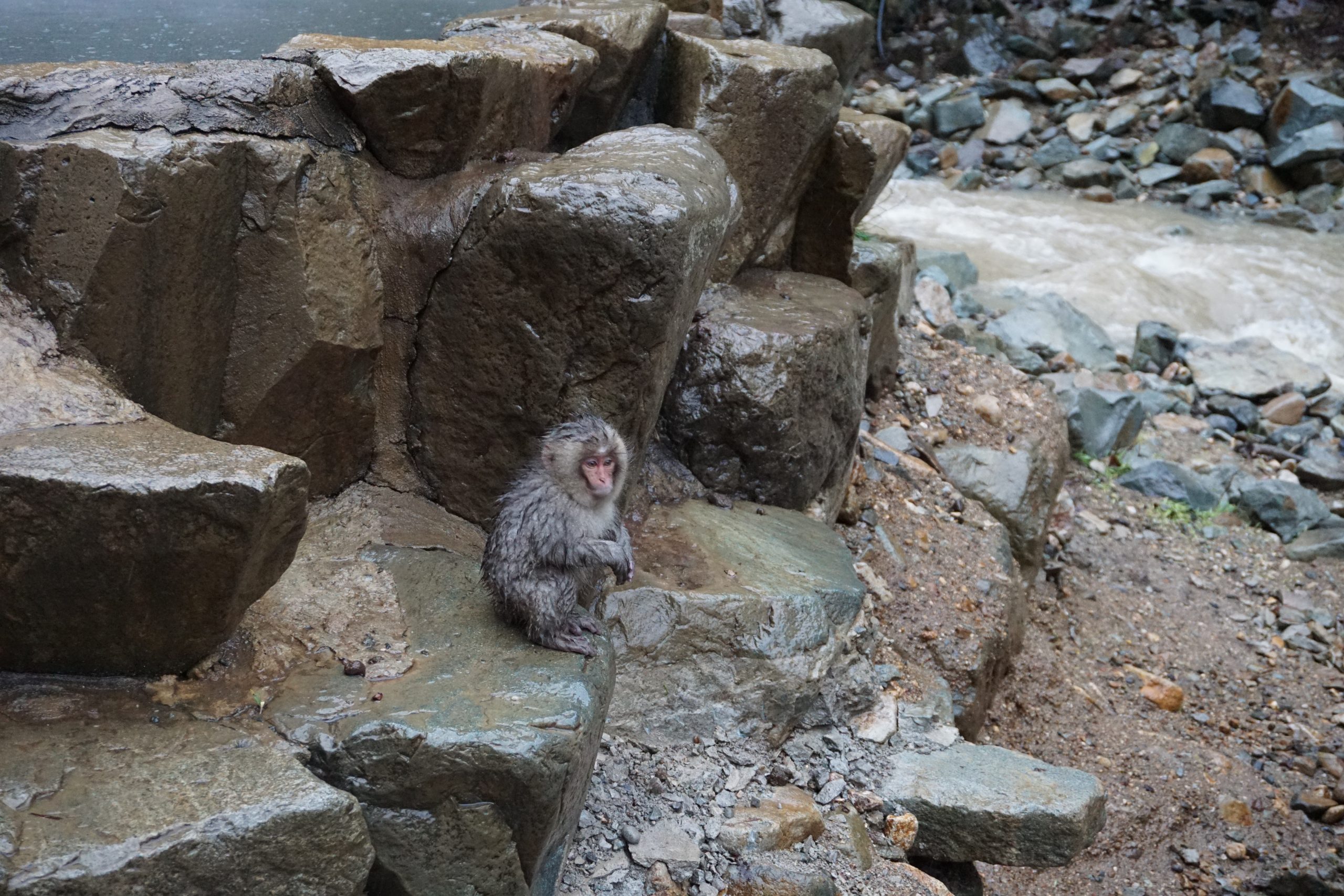
Japan is famous for its snow monkeys (Japanese macaques) and at Jigokudani Monkey Park you can see them in their natural habitat, bathing in an onsen. The Snow Monkey Park is located in Yokoyu River Valley and named “Jigokudani,” meaning “Hell’s Valley” due to the steep cliffs, dense forests, and hot steam rising from the geothermal springs in the area.
The main draw at this park is being able to see monkeys bathing and socialising with one another while relaxing in a natural hot spring. Needless to say that this park is especially popular during the winter months, when the monkeys are more likely to frequent the hot springs due to the colder temperatures. The park supports research and education efforts to understand the snow monkeys and their ecosystem better.
To reach the park is an adventure in itself, especially if you decide to do it as a day trip from Tokyo. You will need the Shinkansen from Tokyo to Nagano, change to a local train, take a bus, then hike along a scenic trail through a forested area.
Nearby, there is the Yudanaka onsen town, ideal for a night spent in a ryokan with traditional Japanese hospitality and relaxing hot springs.
Yakushima Island, Kagoshima
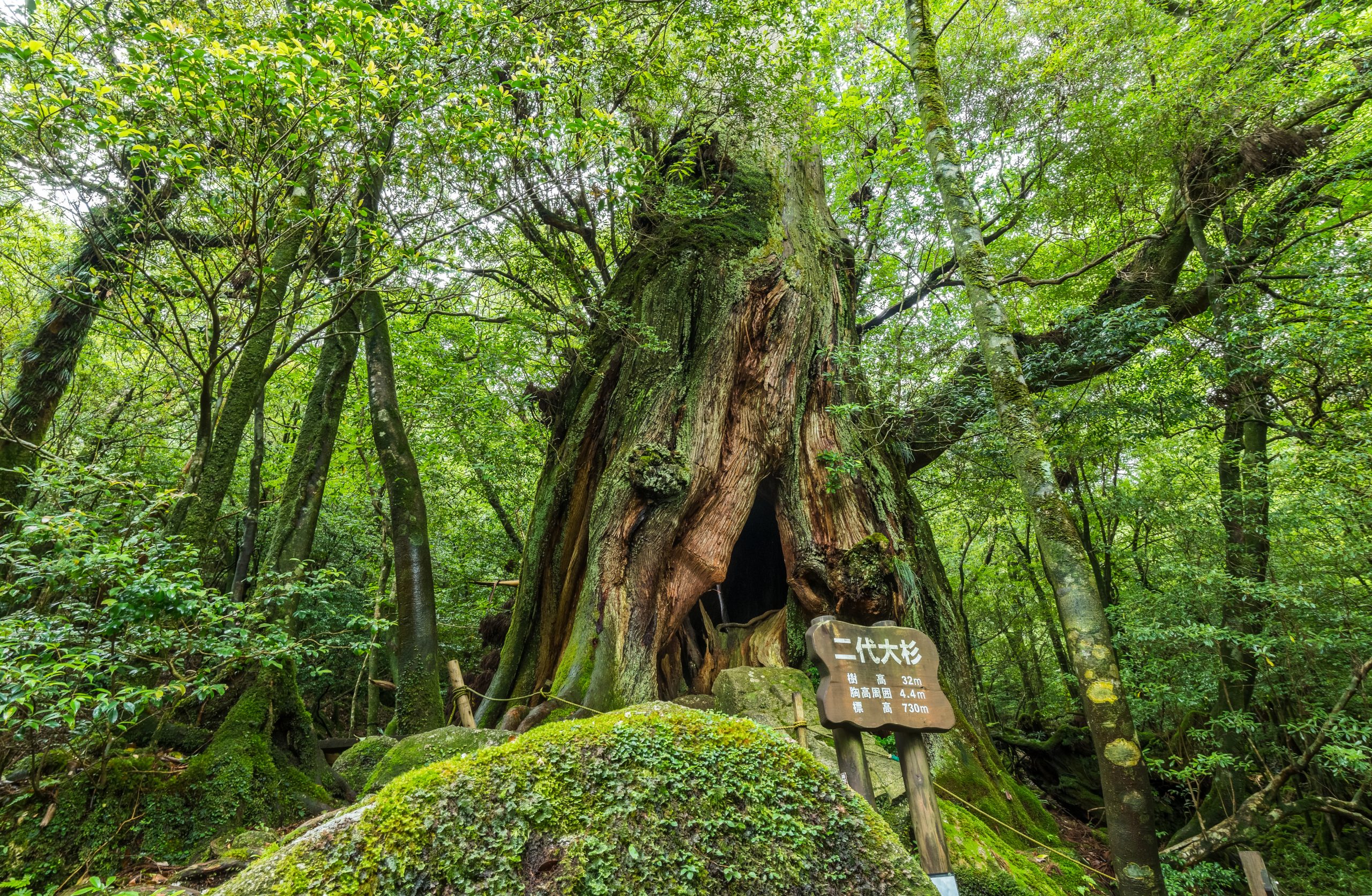
Yakushima Island is a subtropical island located in Kagoshima Prefecture, an enchanting destination just off the coast of Kyushu. The island was designated as a UNESCO World Heritage Site in 1993, in recognition of its ecosystem, which has remained largely untouched for thousands of years.
What makes Yakushima Island incredible is its ancient cedar trees, known as Yakusugi. These trees are native to the island, and some Yakusugi are estimated to be over 1,000 years old. The most famous tree, Jomon Sugi is believed to be between 2,170 and 7,200 years old.
Visiting this island is fantastic for any hiking and nature lovers. You’ll pass through dense forests, see waterfalls, hike towards mountain peaks and see incredible coastal scenery. The most popular hiking route on Yakushima is the Shiratani Unsuikyo Ravine, which inspired the forest scenery in the famous Studio Ghibli film “Princess Mononoke.”
You can sleep on Yakushima as there are several accommodation options, including some which are deeper in nature, but for which you do require a car. To reach the island, you can fly in or take a speedy ferry from Kagoshima.
Kiyomizu-Dera, Kyoto
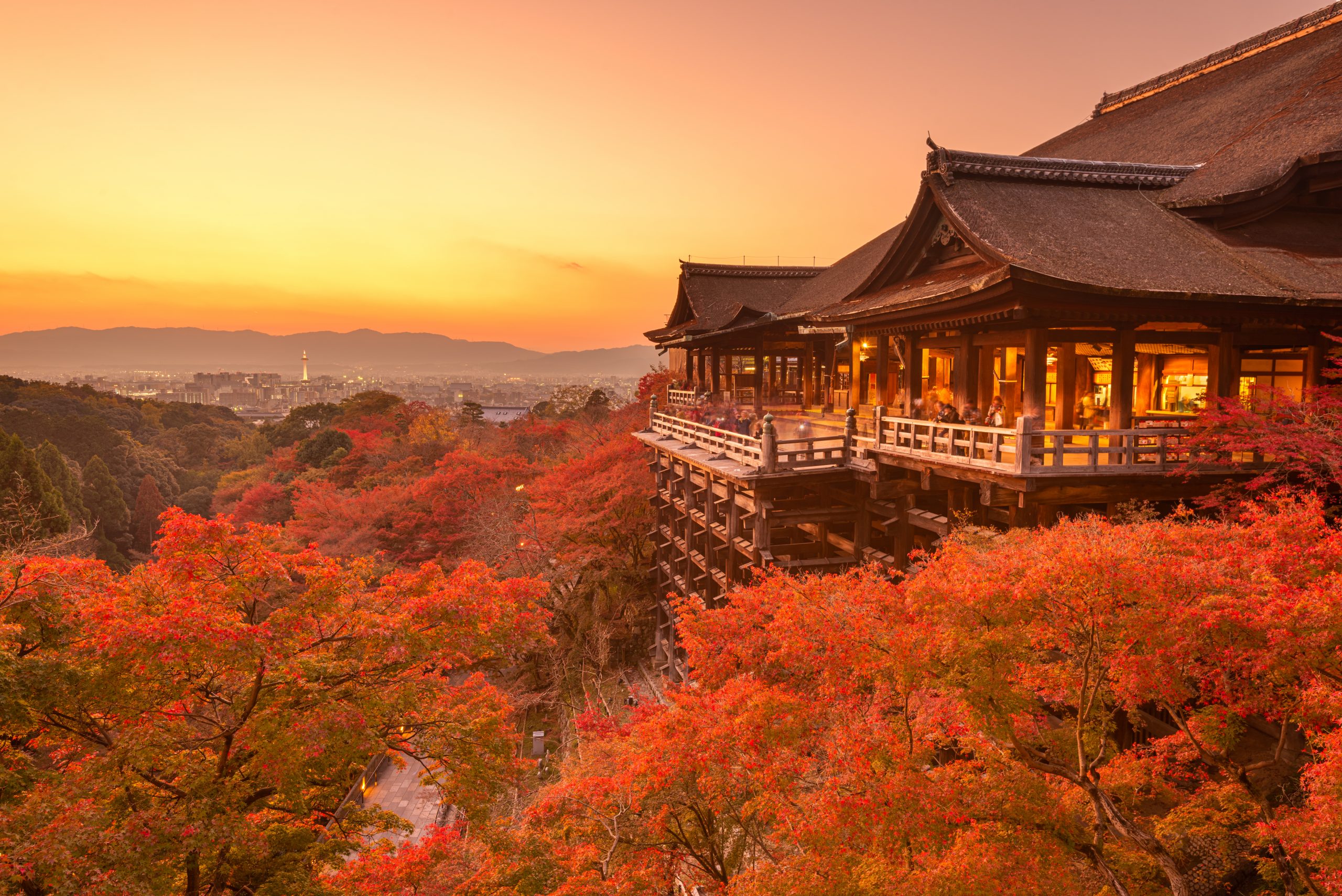
Kiyomizu-dera is a beautiful temple in the city of Kyoto and one of the most popular tourist attractions in Japan thanks to its architecture, panoramic views from its wooden terrace and sacred waters.
The temple was founded in 778 and the main hall is built on a wooden terrace supported by wooden pillars. But there’s more to the wooden terrace than just providing a platforms for beautiful views.
The Japanese have a popular expression “to jump off the stage at Kiyomizu” which is the equivalent of the English idiom taking the plunge. During the Edo period, there was a tradition that involved jumping from a 13-meter (43-foot) stage. Surviving the jump was believed to grant one’s wish. Records from that time indicate that 234 jumps were recorded. Nobody will be jumping off the stage at Kiyomizu as the practice was banned in 1872.
Another important attraction at Kiyomizu-dera is the Otawa Waterfall, which flows within the temple grounds. The waterfall splits into three streams, each said to have different benefits, including longevity, success in studies, and a fortunate love life. Pick the long-handled cups to drink from your chosen streams. Adjacent to the main hall, there is the Jishu Shrine, dedicated to Okuninushi, the Shinto god of love and matchmaking.
Kiyomizu-dera is in the Higashiyama district of Kyoto, just 20 minutes walk to the Geisha district of Gion.
Kenrokuen Garden, Ishikawa
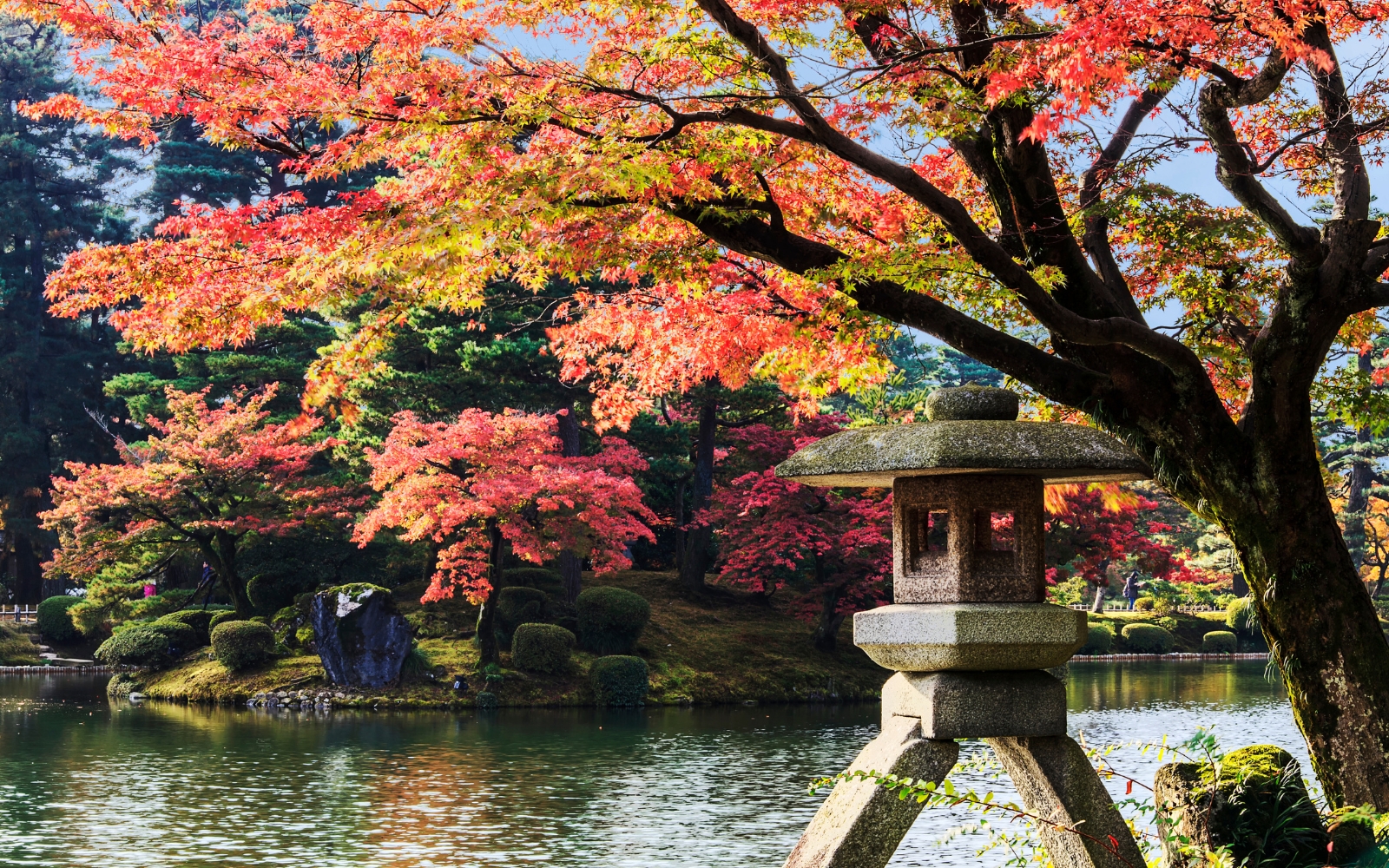
Kenrokuen Garden is one of Japan’s most famous and beautiful traditional landscape gardens, located in Kanazawa. Kenrokuen Garden is considered one of the top three most famous gardens in Japan, alongside Koraku-en, and Kairaku-en. These gardens together are known as “Three Great Gardens of Japan”.
Originally constructed in the 17th century as part of the outer garden for Kanazawa Castle, Kenrokuen Garden was later opened to the public in 1871. The garden spans approximately 25 acres and features a variety of elements, including ponds, streams, bridges, tea houses, and carefully arranged trees and flowers.
Tokyo Yokocho, Tokyo
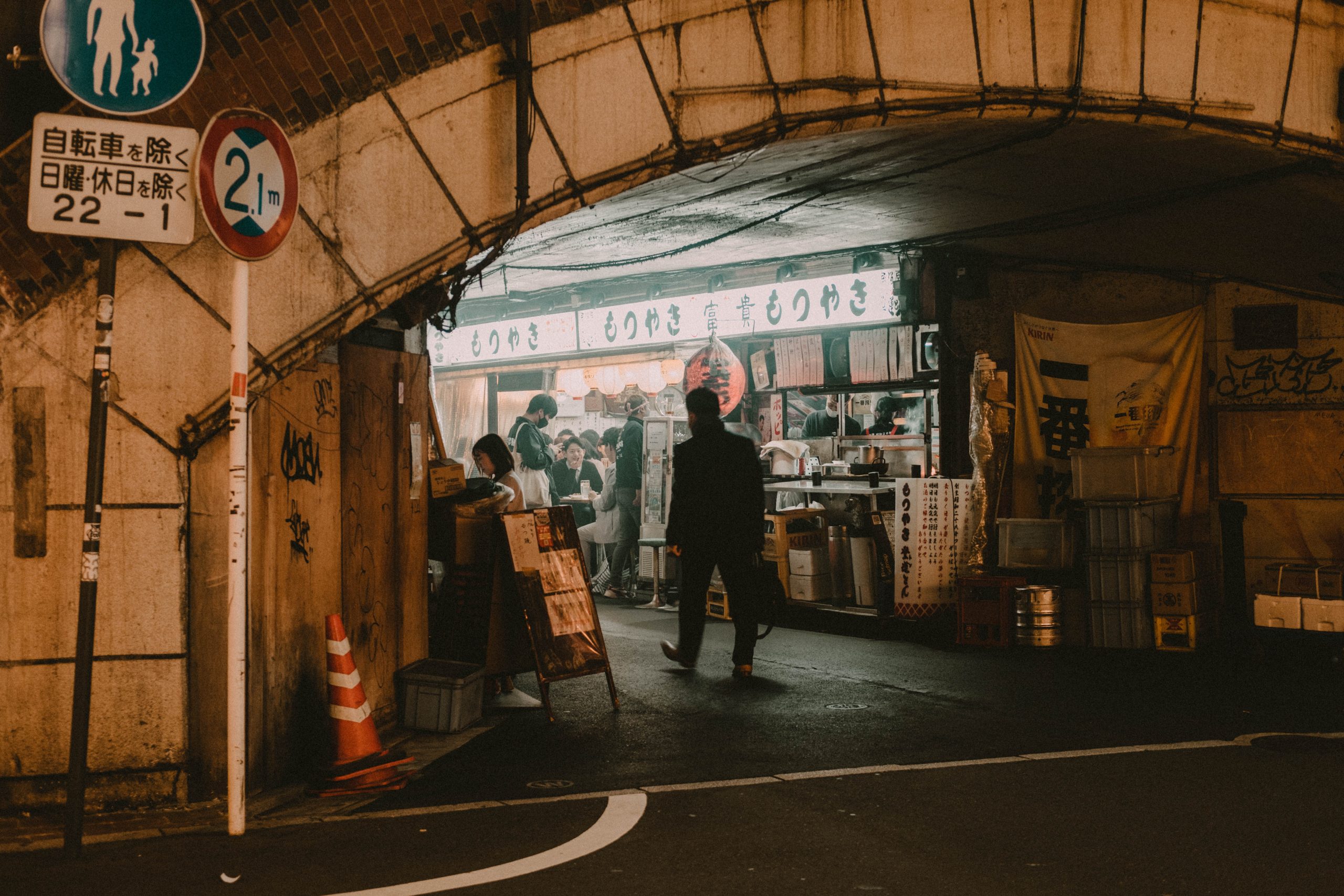
Tokyo’s Yokocho alleys, while not traditional landmarks like temples or shrines, have gained fame and recognition for their distinct nostalgic Showa Era atmosphere. Yokocho, which translates to “side alleys” are narrow streets filled with small bars, eateries, and izakayas.
There are several well-known Yokocho alleys scattered throughout Tokyo, such as Omoide Yokocho in Shinjuku, Golden Gai in Kabukicho, Nonbei Yokocho in Shibuya, and Ebisu Yokocho in Ebisu. Each Yokocho has its own distinct character, and every bar and restaurant has a unique feature too.
Chureito Pagoda, Yamanashi
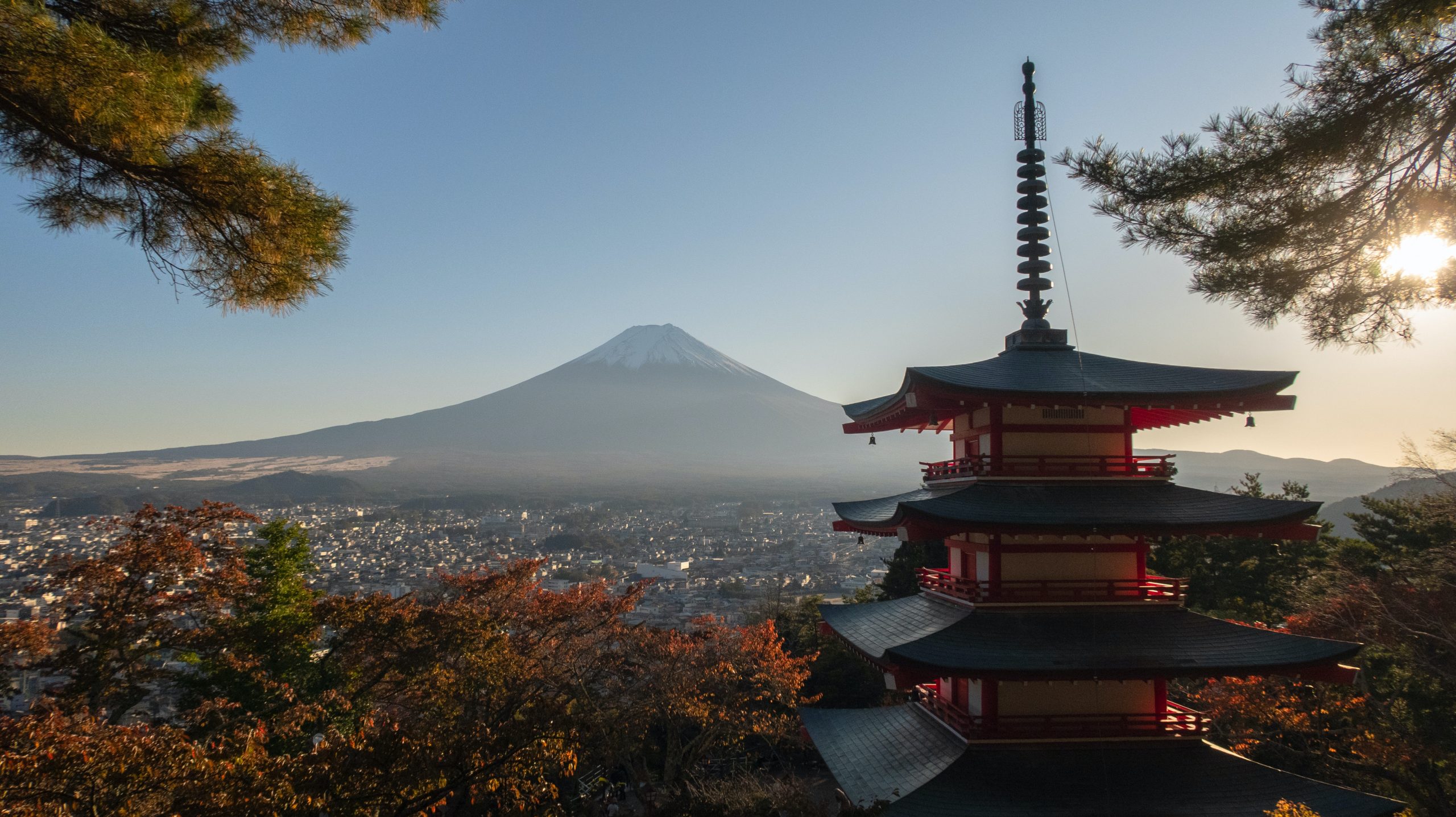
Chureito Pagoda (Arakura Sengen Shrine’s five-story pagoda), is a famous landmark in Japan, known for its stunning views and postcard perfect setting. It is located in the town of Fujiyoshida in Yamanashi Prefecture, about two hours away from Tokyo. The pagoda is part of the Arakura Sengen Shrine complex, which was built as a peace memorial in 1963.
The Chureito Pagoda is particularly famous for its breathtaking panoramic views of Mount Fuji, especially during the cherry blossom season and the fall foliage season.
Blue Pond, Hokkaido
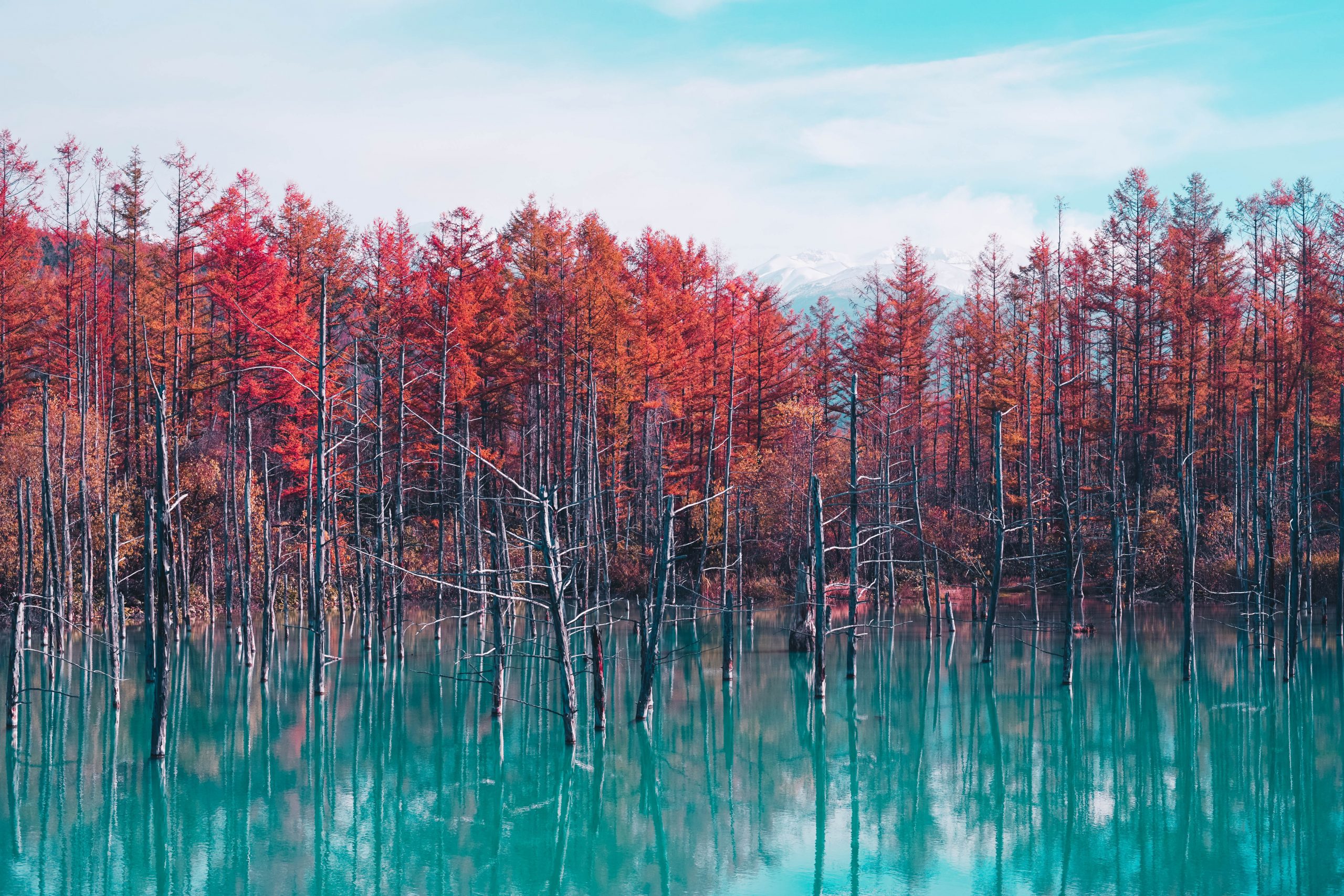
The Blue Pond (Aoiike in Japanese), is a famous and mesmerizing natural attraction located in Biei, a small town in Hokkaido.
It has gained popularity for its stunning, vibrant blue colour, which is a result of natural minerals dissolved in the water. The colour can change depending on the season, weather, and lighting conditions. The presence of aluminium hydroxide in the water, combined with the way sunlight reflects off the suspended particles, creates the pond’s mesmerizing blue hue.
To visit the Blue Pond, you can take a train from Sapporo to Asahikawa and then transfer to a local bus bound for Biei. The journey takes about three hours.
Seiganto-ji, Wakayama
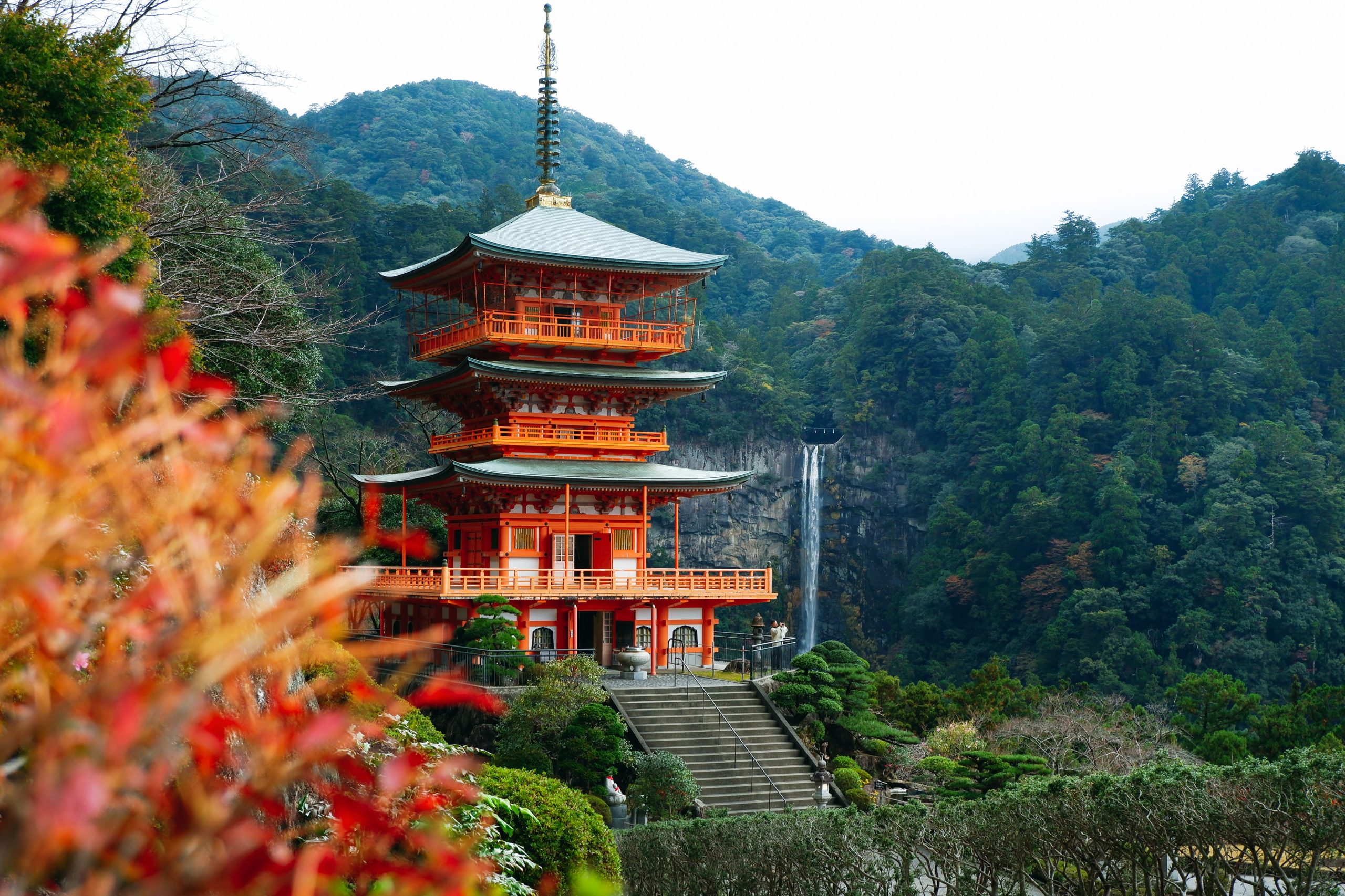
Seiganto-ji is a historic Buddhist temple in Wakayama Prefecture, a famous landmark in Japan thanks to its picturesque location near Nachi Falls. It is part of the UNESCO World Heritage Site “Sacred Sites and Pilgrimage Routes in the Kii Mountain Range” and holds great significance for both religious and cultural tourism.
The templeis located in a breathtaking natural landscape, including the tallest waterfall in Japan, Nachi Falls. To reach Seiganto-ji take a train from Osaka or Kyoto to Kii-Katsuura Station and transfer to a local bus.
Yoshino Trees, Nara
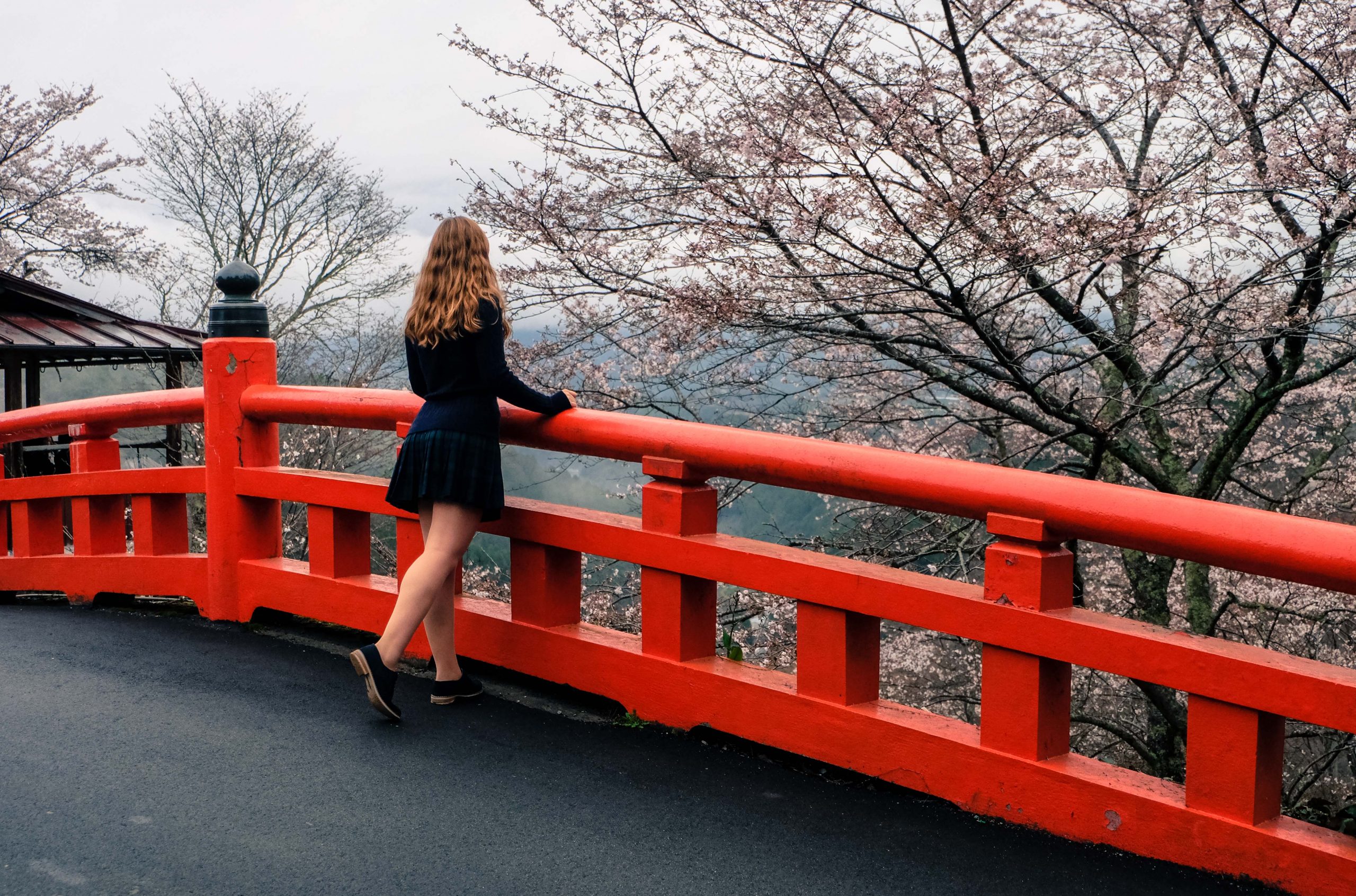
Widely considered the most beautiful place to see the cherry blossoms, Yoshino is a picturesque town located in the Nara Prefecture of Japan, nestled within the Kii Mountains.
The town is famous for its beautiful cherry blossoms, with over 30,000 cherry trees spread across the mountain slopes. Yoshino is part of the UNESCO World Heritage Site “Sacred Sites and Pilgrimage Routes in the Kii Mountain Range” which encompasses several sacred temples, shrines, and pilgrimage routes.
Frequently Asked Questions
What is Japan’s most famous landmark?
Mount Fuji is arguably the most famous landmark in Japan. As the highest mountain in Japan at 3,776 meters (12,388 feet), it has become a symbol of Japan’s natural beauty and cultural heritage.
Mount Fuji is just 100 km from Tokyo and is renowned for its perfectly symmetrical cone shape and its stunning views, especially during the cherry blossom season in spring and autumn, when the leaves change colour.
What are 4 landmarks of Japan?
There are many famous landmarks in Japan, but here are four of the most iconic ones:
Mount Fuji – The highest mountain in Japan, located on Honshu Island.
Fushimi Inari Shrine – An important Shinto shrine famous for its thousands of vermilion torii gates, located in Kyoto.
Shibuya Crossing – The busiest pedestrian crossing in the world located in the heart of Tokyo.
Himeji Castle – A UNESCO World Heritage Site and one of the best-preserved castles in Japan, located in Himeji, Hyogo Prefecture.
Who is a famous landmark in Tokyo?
Here are the top 5 most iconic landmarks in Tokyo:
Tokyo Skytree – The tallest tower in the world, with observation decks offering panoramic views of the city.
Shibuya Crossing – The busiest pedestrian crossings in the world, surrounded by neon lights and video screens.
Tokyo Tower – A landmark tower in Tokyo that was inspired by the Eiffel Tower and offers views of the city from its observation decks.
Meiji Shrine – A Shinto shrine located in Shibuya that is surrounded by a tranquil forest.
Senso-ji Temple – An ancient Buddhist temple located in Asakusa, Tokyo, famous for its towering red lantern and bustling Nakamise shopping street.
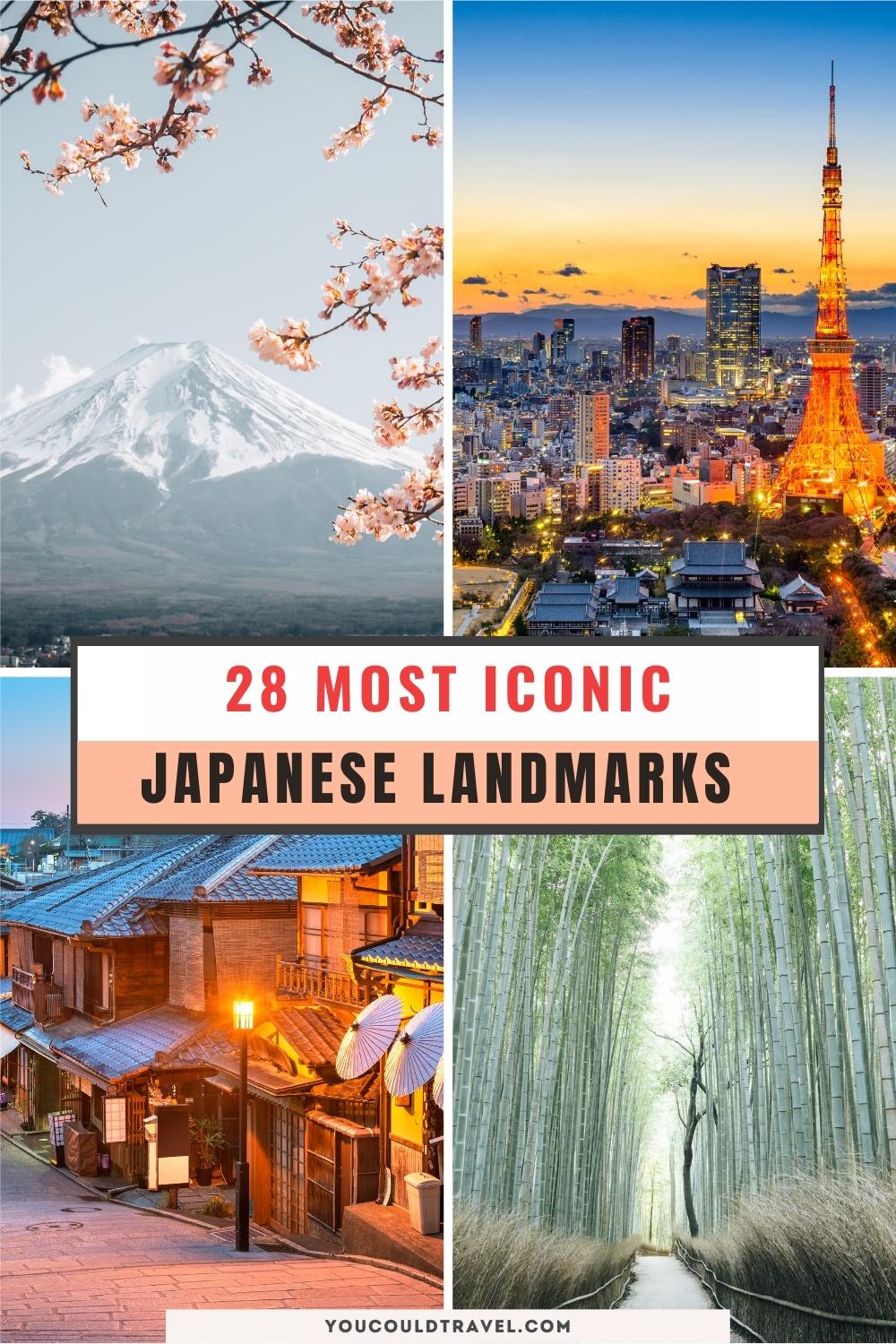



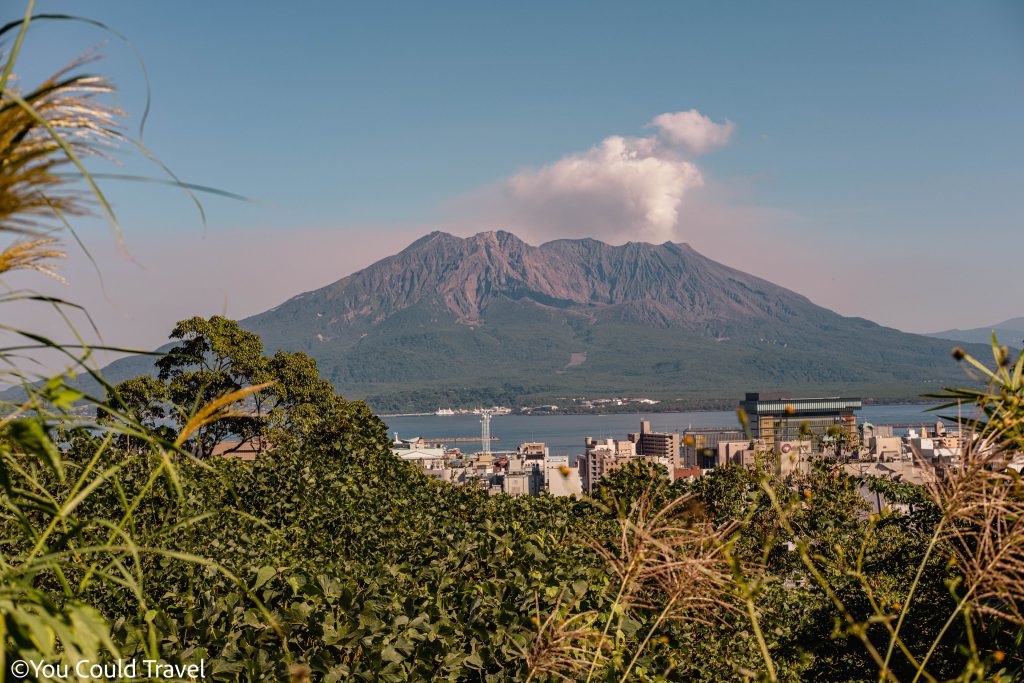
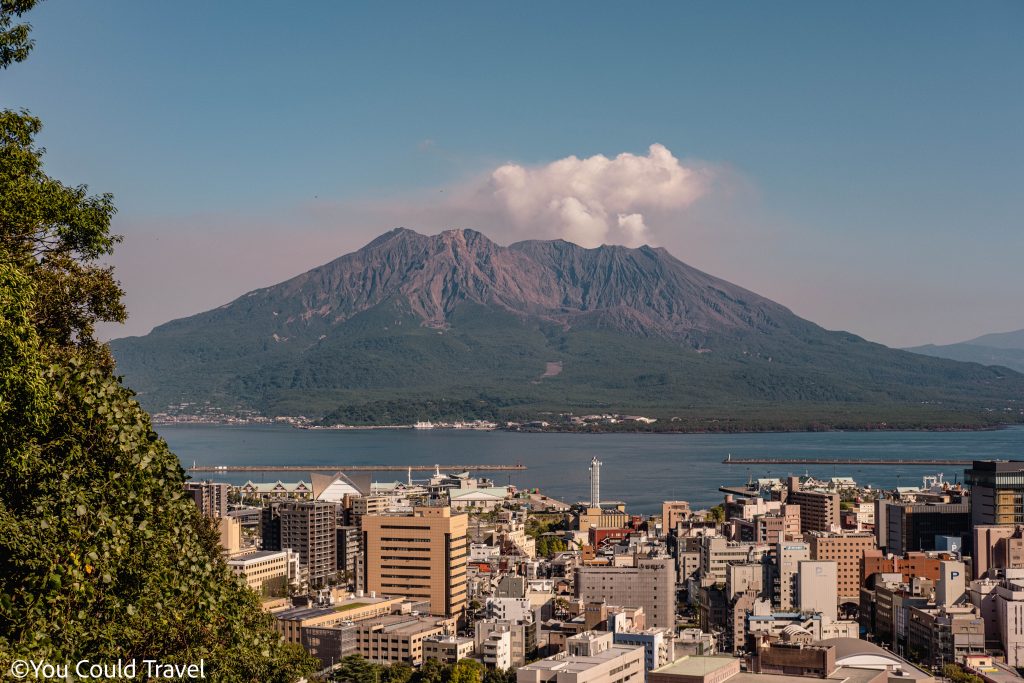
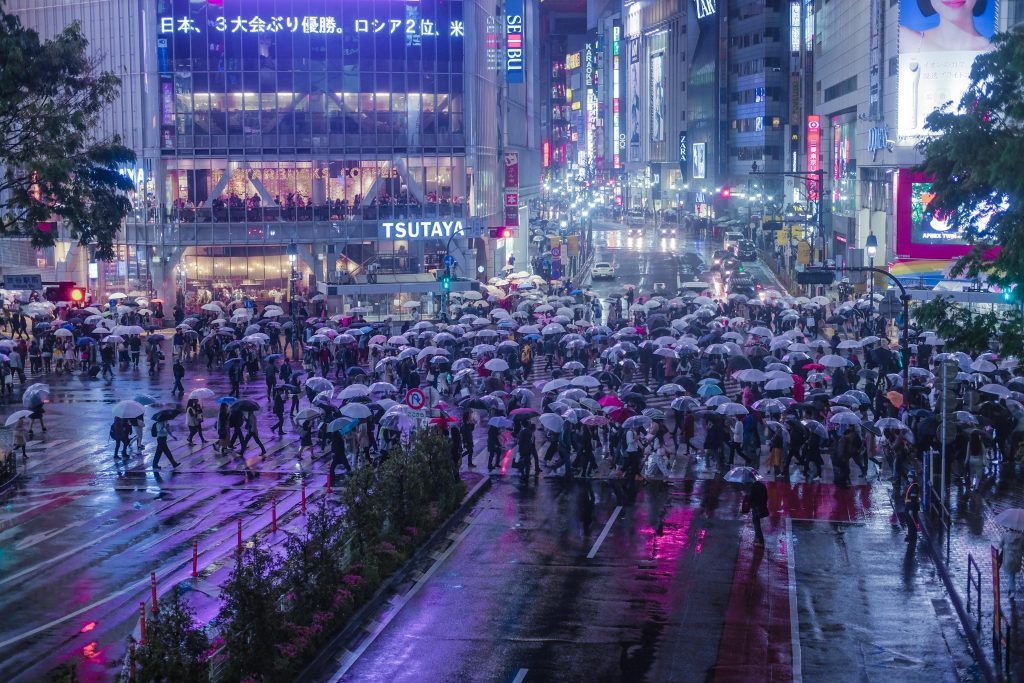
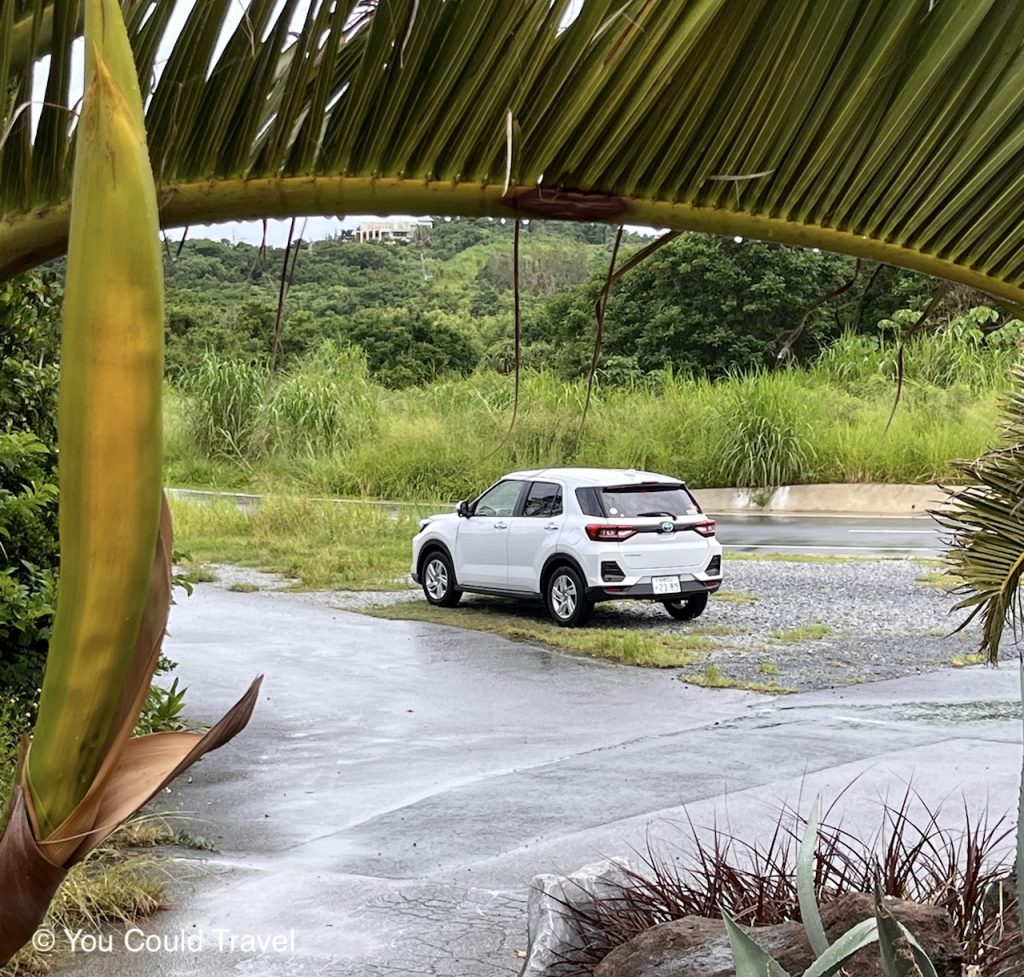
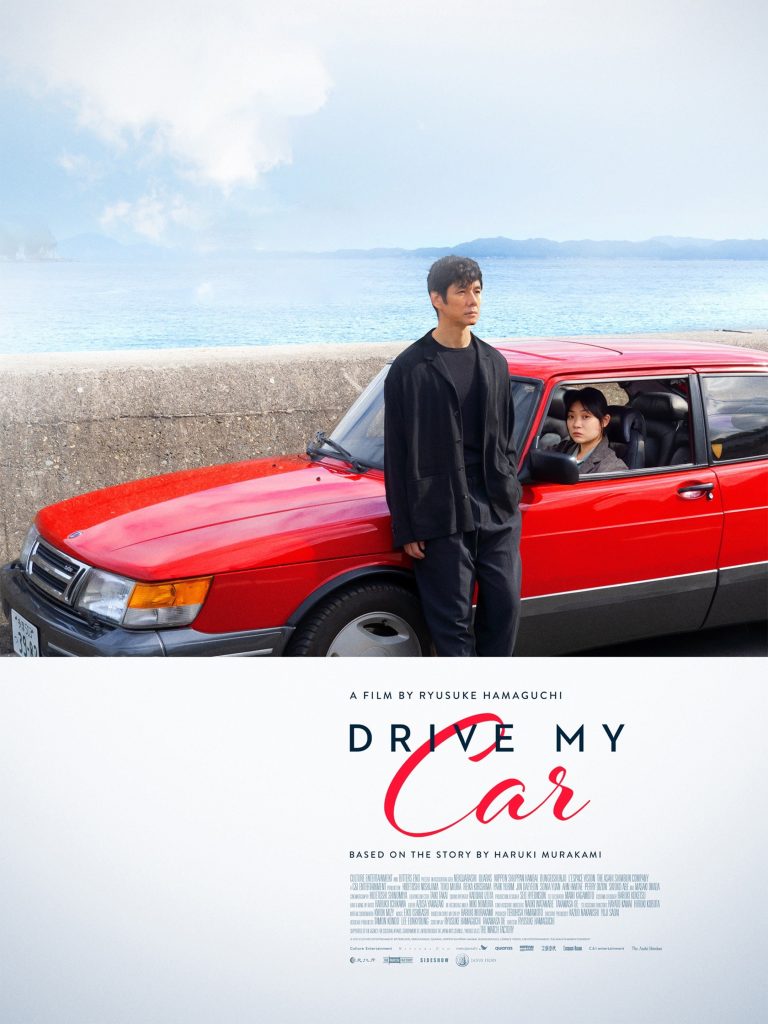


Leave a Reply